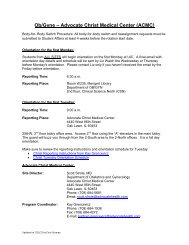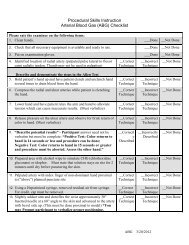Housestaff Survival Guide Crosscover Specialty Procedures + Calcs ...
Housestaff Survival Guide Crosscover Specialty Procedures + Calcs ...
Housestaff Survival Guide Crosscover Specialty Procedures + Calcs ...
Create successful ePaper yourself
Turn your PDF publications into a flip-book with our unique Google optimized e-Paper software.
Home<br />
Sign-out<br />
<strong>Crosscover</strong><br />
<strong>Specialty</strong><br />
<strong>Procedures</strong> + <strong>Calcs</strong><br />
Electrolytes<br />
Call <strong>Survival</strong> Tips<br />
Phone Numbers<br />
HOME<br />
<strong>Housestaff</strong> <strong>Survival</strong><br />
<strong>Guide</strong><br />
<strong>Housestaff</strong><br />
<strong>Survival</strong> <strong>Guide</strong><br />
HOME<br />
Welcome to the online <strong>Housestaff</strong> <strong>Survival</strong> <strong>Guide</strong>.<br />
The purpose of this website is to provide residents with quick online access to the all the information in their<br />
housestaff survival manuals, and beyond.<br />
How to use this site:<br />
Use the links on the left to navigate. You can find most of this information in your copy of the <strong>Housestaff</strong><br />
<strong>Survival</strong> <strong>Guide</strong>. This website combines this guide with links to useful online resources. Here’s what you will<br />
find:<br />
<strong>Crosscover</strong>: common overnight issues, such as chest pain/sob<br />
<strong>Specialty</strong>: common overnight issues for specialty services, such as heme/onc and sickle cell<br />
<strong>Procedures</strong>+Calculators: information on interventions such as procedures, O2 and ECGs<br />
Electrolytes: a quick reference for daily electrolyte repletion<br />
Call survival tips: a collection of on-call tips, and more<br />
Phone Numbers: a collection of phone numbers, pagers, tips, and more<br />
Other important sites:<br />
Online ICU <strong>Guide</strong>book<br />
UIH Clinical Care <strong>Guide</strong>lines<br />
New-Innovations<br />
AMION [cards]
Home<br />
Sign-out<br />
<strong>Crosscover</strong><br />
<strong>Specialty</strong><br />
<strong>Procedures</strong> + <strong>Calcs</strong><br />
Electrolytes<br />
Call <strong>Survival</strong> Tips<br />
Phone Numbers<br />
<strong>Crosscover</strong><br />
<strong>Housestaff</strong><br />
<strong>Survival</strong> <strong>Guide</strong><br />
CV<br />
Chest pain<br />
Hypotension / HTN<br />
Tachycardia / Bradycardia<br />
Pulm Shortness of breath<br />
GI<br />
Neuro<br />
<strong>Housestaff</strong><br />
<strong>Survival</strong> <strong>Guide</strong><br />
<strong>Crosscover</strong><br />
Abdominal pain<br />
Nausea and Vomiting<br />
Constipation / Diarrhea<br />
GI Bleeds<br />
Etoh withdrawal<br />
Seizures<br />
AMS / Sundowning<br />
Other<br />
ID<br />
Renal<br />
Fever<br />
Antibiotics<br />
Vancomycin dosing<br />
Oliguria<br />
Hyperkalemia<br />
Hypo and Hyperglycemia<br />
Pruritus / Rash<br />
Pain<br />
Decision making capacity<br />
Death pronouncement
Home<br />
Sign-out<br />
<strong>Crosscover</strong><br />
<strong>Specialty</strong><br />
<strong>Procedures</strong> + <strong>Calcs</strong><br />
Electrolytes<br />
Call <strong>Survival</strong> Tips<br />
Phone Numbers<br />
<strong>Crosscover</strong><br />
<strong>Housestaff</strong><br />
<strong>Survival</strong> <strong>Guide</strong><br />
<strong>Housestaff</strong> <strong>Survival</strong> <strong>Guide</strong> | <strong>Crosscover</strong> | Chest pain<br />
On the phone:<br />
Ask for complete vitals; Try to get a good history on the phone.<br />
Onset (gradual = ischemia, pneumonia vs sudden = PE, aortic dissection, PTX)<br />
Crushing, squeezing, pressure (MI); severe tearing with sudden onset (dissection)<br />
Dull/sharp/pleuritic; radiation; location; alleviating factors; assoc’d sx (nausea, vomiting, cough,<br />
hemoptysis); cardiac risk factors<br />
Based on your first impression, order immediate tests and let the nurse know. Order an EKG, CXR, Cardiac biomarkers, Coags required unless<br />
clear musculoskeletal pain.<br />
Always go see the patient. It will eliminate all doubts and help you create a clear picture of what’s going on. See the patient – assess<br />
hemodynamic stability<br />
PE: all vital signs; BP in each arm and pulses in both arms and legs (aortic dissection)<br />
CV: new murmurs, extra heart sounds, JVP, carotid pulses, sternum/chest wall pain with palpation<br />
Lungs: crackles, decreased breath sounds, hyper-resonant percussion, friction rub, trachea deviation<br />
Abd: tenderness, BS<br />
Ext: Leg edema (CHF, DVT)<br />
Based on your history and physical, continue with further workup. Lets go through the differential: CV (Angina, MI, pericarditis, dissection), Pulm<br />
(PE, PTX, PNA, Effusion) Gi (Esoph spasm, rupture, GERD, PUD, Pancreatitis) Msk (Costochondritis, Zoster, etc)<br />
CV<br />
If concern for coronary etiology<br />
What to think/risk stratification<br />
What type of chest pain is it (typical vs atypical)? What are his risk<br />
factors?<br />
What is his TIMI score?<br />
What to order immediately<br />
Cardiac enzymes: 3 sets of enzymes and EKG q6hrs, transfer to telemetry<br />
ABG if pulse ox 90);<br />
or 1 inch topical/paste<br />
Can give morphine if pain still not controlled; can repeat if SBP>90 and<br />
RR okay<br />
Order telemetry<br />
If acute coronary syndrome: consider heparin; discuss w/Cards fellow<br />
and consider CCU<br />
If concerned for aortic dissection:<br />
Check BP on both arms<br />
Consider CT Angio<br />
Call senior; discuss w/CTSurg or vascular<br />
Control BP w/labetalol or nitroprusside drips for BP<br />
Transfer to CCU/MICU<br />
• TIMI<br />
• Shortness of breath<br />
• ECG <strong>Guide</strong><br />
Quick Links<br />
Pulm<br />
If you suspect a PE<br />
What to think/risk stratification<br />
What type of chest pain is it (typical vs<br />
atypical)? What are his risk factors?<br />
What are his O2 requirements and VS?<br />
What is the patients Well’s Score?<br />
What to order immediately<br />
O2<br />
CT w/PE protocol [if Cr wnl] > If unable to perform: VQ in AM<br />
If high pre-test probability: empiric<br />
anticoagulation<br />
ABG<br />
If you suspect a PTX<br />
CXR upright with inspiration and expiration<br />
If present and is > 20% of lung: call surgery for<br />
chest tube<br />
100% oxygen non-rebreather: improves reabsorption<br />
If tension PTX: 16-guage IV catheter in second intercostal space,<br />
then chest tube<br />
GI<br />
Aluminum hydroxide (Maalox) 30mL po q4hrs, famotidine (Pepcid)<br />
20mg po BID,<br />
omeprazole 20mg daily; elevate HOB<br />
Other: Write a note; avoid morphine until dx and tx are established<br />
Re-assess as needed
Home<br />
Sign-out<br />
<strong>Crosscover</strong><br />
<strong>Specialty</strong><br />
<strong>Procedures</strong> + <strong>Calcs</strong><br />
Electrolytes<br />
Call <strong>Survival</strong> Tips<br />
Phone Numbers<br />
<strong>Crosscover</strong><br />
<strong>Housestaff</strong><br />
<strong>Survival</strong> <strong>Guide</strong><br />
<strong>Housestaff</strong> <strong>Survival</strong> <strong>Guide</strong> | <strong>Crosscover</strong> | Hypotension<br />
Recall that BP = CO x SVR, Low cardiac output: cardiogenic (acute MI, worsening CHF, tamponade) hypovolemia, PE, tension PTX, tense ascites<br />
Low vascular resistance: sepsis, anaphylaxis, medications, adrenal insufficiency<br />
First: Assess for SHOCK: decreased organ perfusion: brain (mental status), heart (chest pain), kidneys (urine output <br />
cardiogenic<br />
warm skin, fever: -> sepsis<br />
warm skin, rash, wheezing, stridor: -><br />
anaphylaxis
Home<br />
Sign-out<br />
<strong>Crosscover</strong><br />
<strong>Specialty</strong><br />
<strong>Procedures</strong> + <strong>Calcs</strong><br />
Electrolytes<br />
Call <strong>Survival</strong> Tips<br />
Phone Numbers<br />
<strong>Crosscover</strong><br />
<strong>Housestaff</strong><br />
<strong>Survival</strong> <strong>Guide</strong><br />
<strong>Housestaff</strong> <strong>Survival</strong> <strong>Guide</strong> | <strong>Crosscover</strong> | Hypertension<br />
First: Ask for complete vital signs, repeat manual BP yourself (use<br />
larger cuff if needed)<br />
Hx: Review baseline BP: Acute increases in BP are more<br />
dangerous.<br />
Assess for chest pain, back pain (dissection), change in MS, change<br />
in vision, unilateral weakness or<br />
decreased sensation (stroke), SOB (pulmonary edema).<br />
If there is any evidence of end-organ damage (myocardial<br />
ischemia, hematuria, proteinuria, CNS<br />
symptoms), this is Hypertensive Emergency<br />
PE: BP in both arms (aortic dissection); HR (bradycardia may =<br />
increased ICP);<br />
Gen: mentation; how sick is the pt?<br />
HEENT: papilledema, retinal hemorrhages or exudates, arteriolar<br />
narrowing<br />
CV: elevated JVP, S3<br />
Lungs: crackles (pulmonary edema), decreased sounds (effusion)<br />
Neuro: mental status, confusion, delirium, lethargy<br />
(encephalopathy), any localized deficits (stroke)<br />
Tests: If concern for urgency/emergency consider UA (for<br />
blood/protein); EKG; CXR (widened<br />
mediastinum for aortic dissection); non-contrast head CT for<br />
subarachnoid hemorrhage or CVA<br />
(only hemorrhagic strokes are evident)<br />
DDX: pain, anxiety, nausea, alcohol withdrawal are common, but<br />
Do Not Miss: hypertensive emergency associated with<br />
hypertensive encephalopathy, aortic<br />
dissection, pulm edema, MI, subarachnoid or cerebral<br />
hemorrhage<br />
Management: Treat pain and anxiety. If pt is asymptomatic, may<br />
watch and wait until morning or<br />
review medications and give additional dose of an oral BP<br />
medication the pt is already taking;<br />
Consider stopping IVF. Aim for slow decrease in BP if it’s chronic.<br />
. . . or see below . . .<br />
(avoid reflexively ordering hydralazine and other meds that are<br />
difficult for the pt to take at home)<br />
**Blood pressure for post-stroke/neurology patient is DIFFERENT -<br />
> usually BP >180/100 to<br />
maintain adequate cerebral perfusion (CPP = MAP – intracranial<br />
pressure)**<br />
Hypertensive Urgency: asymptomatic; SBP >220, DBP >120<br />
Treatment: PO antihypertensives, decrease MAP by 25% or to<br />
160/110 over several hours<br />
First try to increase doses of meds pt is already taking; or consider<br />
Labetalol 50mg po,<br />
Nitropaste 1 inch topical (also helpful with chest pain),<br />
Hydralazine 25mg po (risk of rebound tachycardia; avoid with<br />
dissection or wide pulse pressure),<br />
Clonidine 0.1-0.3mg po (risk of rebound hypertension).<br />
Recheck BP in 1.5-2 hours after giving po meds<br />
Ask your senior before giving IV antihypertensive as acute drop in<br />
BP can cause stroke.<br />
Hypertensive Emergency: see pt, EKG, IV access – will need MICU<br />
Evidence of end-organ damage<br />
Neuro: encephalopathy (HA, N/V, confusion, seizures),<br />
CVA, SAH (HA, stiff neck)<br />
Cardiac: MI, angina, LVF, aortic dissection (back and chest<br />
pain)<br />
Pulm: pulmonary edema (SOB)<br />
Renal: ARF, proteinuria, hematuria<br />
Treatment: Goal: decrease MAP by 25% (max.) over 1hr to avoid<br />
watershed infarct<br />
- While transferring to the MICU:<br />
Nifedipine 5-10mg po and may repeat in 30min, or<br />
Labetalol<br />
20mg IV q15min or 200mg PO<br />
- In the MICU:<br />
Nitroglycerine IV 5mcg/min – titrate (first-line for cardiac<br />
patients)<br />
Nitroprusside 0.3mcg/kg/min – titrate (usual is 0.5-<br />
10mcg/kg/min)<br />
Esmolol load 500mcg/kg, then 50mcg/kg/min infusion<br />
If active myocardial ischemia or infarction, also use Bblocker<br />
(also consider for h/o MI or CVA)<br />
If Cocaine-induced hypertension: avoid B-blockers that<br />
cause unopposed alpha stimulation; use<br />
labetalol, nitroprusside, phentolamine<br />
If Amphetamine-induced hypertension: consider<br />
chlorpromazine 1mg/kg IM
Home<br />
Sign-out<br />
<strong>Crosscover</strong><br />
<strong>Specialty</strong><br />
<strong>Procedures</strong> + <strong>Calcs</strong><br />
Electrolytes<br />
Call <strong>Survival</strong> Tips<br />
Phone Numbers<br />
<strong>Crosscover</strong><br />
<strong>Housestaff</strong><br />
<strong>Survival</strong> <strong>Guide</strong><br />
<strong>Housestaff</strong> <strong>Survival</strong> <strong>Guide</strong> | <strong>Crosscover</strong> | Tachycardia<br />
First:<br />
-assess pt and vitals: ABCDs, get EKG<br />
-low BP or symptomatic (decreased alertness, pulm edema, chest pain) – call your senior, may need<br />
DC conversion<br />
-non-sustained V tach – check electrolytes and replace<br />
-sustained (> 30 sec.) – assess hemodynamic stability; consider calling a code if pt is unstable<br />
Hx:<br />
chest pain, palpitations, SOB, previous episodes, h/o cardiac or thromboembolic disease, drug<br />
hx (incl. recreational, caffeine, smoking, alcohol); assess for causes of sinus tach (pain,<br />
hypovolemia, infection)<br />
PE:<br />
vitals, mentation, JVP, skin temp/cyanosis, cap refill, heart rate, murmurs, lung crackles and<br />
breath sounds, edema or evidence of DVT<br />
Tests:<br />
ECG; consider CBC, glucose, Mg, Ca, Chem, (thyroid)?, ABG if low pulse ox or considering<br />
PE, CXR<br />
DDX:<br />
Narrow Complex Tachycardia:<br />
Regular: sinus tach, SVT, atrial flutter<br />
Irregular: atrial fibrillation, MAT, a. flutter w/ variable conduction<br />
Wide Complex Tachycardia:<br />
do not miss V. Fib<br />
Management: Call your senior and consider emergency cardioversion if hypotensive, unstable with<br />
a fib with RVR or SVT or VT, or vent rate > 150<br />
-oxygen, telemetry, correct electrolytes (Mg, K), underlying causes (infection, hypovolemia, PE),<br />
address management for any primary arrhythmias<br />
-A FIB: with RVR – rate control with diltiazem or beta-blocker if pt is stable<br />
-SVT: may be broken with valsalva, carotid massage (r/o bruits 1st), adenosine 6mg IVP followed<br />
by rapid saline flush, then repeat adenosine 12mg IVP if needed (record on a rhythm strip!!)<br />
-VT without pulse or BP: ACLS management as V. Fib<br />
-NSVT: if infrequent, monomorphic and pt is asymptomatic, check lytes and watch<br />
-MAT: treat pulm disease, rate control (consider CCB like diltiazem, or B-blocker)
Home<br />
Sign-out<br />
<strong>Crosscover</strong><br />
<strong>Specialty</strong><br />
<strong>Procedures</strong> + <strong>Calcs</strong><br />
Electrolytes<br />
Call <strong>Survival</strong> Tips<br />
Phone Numbers<br />
<strong>Crosscover</strong><br />
<strong>Housestaff</strong><br />
<strong>Survival</strong> <strong>Guide</strong><br />
<strong>Housestaff</strong> <strong>Survival</strong> <strong>Guide</strong> | <strong>Crosscover</strong> | Bradycardia<br />
First<br />
Assess pt, vitals, symptoms; Check BP and ECG if HR < 60<br />
If hypotensive or symptomatic, call your senior; give atropine 0.5-1mg IVP (up to 3mg); if no<br />
improvement, consider pacing<br />
If asymptomatic and HR>45; no further interventions<br />
Hx:<br />
falls, dizziness, syncope, h/o CAD, drug hx (esp. b-blocker, non-dihydropyridine CCB, digoxin)<br />
PE:<br />
heart rate, mentation, JVP, cannon waves (heart block), skin temp/cyanosis, cap refill, murmurs,<br />
lung crackles and breath sounds<br />
Tests:<br />
ECG; Assess for heart block: type IIb and III need pacing; labs, digoxin level<br />
DDX: drugs (beta-blockers, digoxin, CCB, amiodarone); sick sinus; MI; AV block; hyperkalemia;<br />
hypothyroid; hypothermia<br />
Management:<br />
Oxygen, telemetry, correct electrolytes (Mg, K), Call your senior and consider<br />
atropine (as above)<br />
If digoxin toxicity: correct K, Mg; talk with senior about digibind antibodies<br />
If B-blocker overdose, may give glucagon 50mcg bolus, then infusion<br />
Consider pacing and transfer to CCU
Home<br />
Sign-out<br />
<strong>Crosscover</strong><br />
<strong>Specialty</strong><br />
<strong>Procedures</strong> + <strong>Calcs</strong><br />
Electrolytes<br />
Call <strong>Survival</strong> Tips<br />
Phone Numbers<br />
<strong>Crosscover</strong><br />
<strong>Housestaff</strong><br />
<strong>Survival</strong> <strong>Guide</strong><br />
<strong>Housestaff</strong> <strong>Survival</strong> <strong>Guide</strong> | <strong>Crosscover</strong> | Shortness of Breath<br />
On the phone:<br />
Get full vitals; onset of SOB; underlying diseases; order oxygen if hypoxic (avoid too much oxygen in CO2 retainers), nebs, ECG,<br />
ABG kit to bedside and go see pt now<br />
Hx<br />
sudden onset (PE, PTX, pulmonary edema) vs. gradual onset (pneumonia, COPD/asthma exacerbation, pulm edema or effusion),<br />
h/o lung or heart disease, associated sx (cough, hemoptysis, fever, chest pain), risk factors for PE or MI<br />
PE:<br />
vitals, use of accessory muscles, midline trachea, signs of cyanosis, JVP, lungs, heart, loud P2, RV heave, edema, mental status<br />
(confused, drowsy)<br />
Tests:<br />
ABG, CXR, EKG, CBC; Consider high-resolution Chest CT with PE protocol (if kidneys can tolerate dye – pre-hydrate with<br />
IVF unless overloaded). Consider Visipaque contrast for high-risk nephropathy. Patient will need 18<br />
gauge IV access for the contrast dye (often can’t use PICC). Generally, can’t get V/Q scans at<br />
night/weekends (that goes for both VA & UIC).<br />
Other: anxiety/pain/opiates/narcotics<br />
Do not miss:<br />
Hypoxia – insufficient tissue oxygenation (look at PO2 – assuming it’s not venous!);<br />
Anaphylaxis (wheezing, itch/urticaria, hypotension)<br />
Management:<br />
-supplemental oxygen (NC, face mask, NRFM, BiPAP 10/5)<br />
-Albuterol/Ipratropium nebs<br />
-Lasix if fluid overloaded, CHF exacerbation (Lasix 40mg IV, if no response, double the dose every 1 hour, e.g. 40mg, 80mg,<br />
160mg, …and consider adding metolazone 2.5mgPO)<br />
-check peak flows if asthma; sputum culture<br />
-if narcotic overdose, give naloxone 0.2 to 2mg IV<br />
-Anaphylaxis tx: Epi (0.3cc of 1:1000epi SC or 3cc of 1:10000epi IV), Hydrocortisone 250mg<br />
IVPB, Benadryl 25-50mg IVPB, Famotidine<br />
Indications for Intubation?<br />
Look for rapid shallow breathing and fatigue. Try to reverse underlying conditions.<br />
1) airway protection 2) decline in mental status 3) pCO2 increasing 4) pO2 < 60, not responding to<br />
supp oxygen 5) pH 50 with pH
Home<br />
Sign-out<br />
<strong>Crosscover</strong><br />
<strong>Specialty</strong><br />
<strong>Procedures</strong> + <strong>Calcs</strong><br />
Electrolytes<br />
Call <strong>Survival</strong> Tips<br />
Phone Numbers<br />
<strong>Crosscover</strong><br />
<strong>Housestaff</strong><br />
<strong>Survival</strong> <strong>Guide</strong><br />
<strong>Housestaff</strong> <strong>Survival</strong> <strong>Guide</strong> | <strong>Crosscover</strong> | Abdominal pain<br />
***Assess for Acute abdomen/Surgical Abdomen!!<br />
Hx<br />
vitals, severity of pain, onset; (red flags: sudden, severe, fever, hypotension)<br />
PE:<br />
serial abd exams: Look for peritoneal signs: Rebound tenderness (pain w/ percussion of abd)<br />
(Unlikely to be peritoneal if pt can cough, laugh, sit up or roll, or if not bothered when you nudge<br />
the bed)<br />
Abd: Bowel sounds (high with SBO, absent with ileus), percussion – tympany, shifting dullness,<br />
palpation – guarding, rebound, Murphy’s, psoas, obturator, CVA tenderness<br />
Consider rectal or pelvic exam<br />
Tests: consider CBC, Chem, amylase/lipase, ABG, anion gap, lactic acid, LFTs, UA, INR if suspect<br />
liver disease or sepsis; also consider bHCG, cultures, type and cross<br />
Studies: Flat and upright KUB (abdominal obstructive series) and upright CXR (look for air under<br />
diaphragm), consider abdominal CT or US, (no oral contrast if obstructed), EKG<br />
-- get the films read by radiology resident; look for dilated toxic megacolon (>7cm); air under<br />
diaphragm or between viscera and subcutaneous tissue on lat decub; air/fluid levels suggesting<br />
obstruction; gallstone or pancreas calcifications<br />
DDX<br />
-Do not miss: acute abdomen: AAA rupture, bowel perforation, ascending cholangitis, acute<br />
appendicitis, mesenteric ischemia, incarcerated hernia (happens every once in a while on liver<br />
service)<br />
-myocardial infarction<br />
-shock (hypovolemia or sepsis); peritonitis<br />
Management<br />
If acute abdomen, notify general surgery. If not, continue serial abdominal exams.<br />
Make pt NPO, give IVF, hold analgesics while evaluating. Document serial abdominal exams if<br />
indicated.<br />
If suspect obstruction: NPO, place NGT (with low-intermittent suction), serial abd exams q2 hours,<br />
(consider famotidine or ranitidine H2-blockers)
Home<br />
Sign-out<br />
<strong>Crosscover</strong><br />
<strong>Specialty</strong><br />
<strong>Procedures</strong> + <strong>Calcs</strong><br />
Electrolytes<br />
Call <strong>Survival</strong> Tips<br />
Phone Numbers<br />
<strong>Crosscover</strong><br />
<strong>Housestaff</strong><br />
<strong>Survival</strong> <strong>Guide</strong><br />
<strong>Housestaff</strong> <strong>Survival</strong> <strong>Guide</strong> | <strong>Crosscover</strong> | Nausea and vomiting<br />
****Is this an anginal equivalent/atypical chest pain? > go to Chest Pain<br />
Watch for complications – dehydration, electrolytes, acid/base<br />
DDx:<br />
Medications – NSAIDs, erythromycin, morphine, codeine, aminophylline, chemo, digoxin,<br />
antiarrhythmics, nicotine, bromocriptine<br />
Infection – gastroenteritis, otitis media, pharyngitis, CNS, pneumonia<br />
Gut disorder – obstruction, PUD, gastroparesis, hepatobiliary, pancreatic, cancer<br />
CNS – increased ICP, migraine, seizure, anxiety, bulimia/anorexia, pain<br />
Other – MI, metabolic, pregnancy, drugs/alcohol, radiation sickness, Labyrinthine disorders<br />
Tx:<br />
PO if mild, IV if severe<br />
Promethazine (Phenergan) 12.5-25mg po/IV q4-6h (sedating)<br />
Prochlorperazine (Compazine) 5-10mg IV/PO/IM q4-6h PRN, or suppository 25mg bid<br />
Metoclopramide (Reglan) 10mg PO/IV q6h prn (not with obstruction)<br />
Ondansetron (Zofran) 4mg IV (esp with chemo)<br />
Tx of GI upset: PUD, reflux: Maalox (aluminum hydroxide/magnesium hydroxide) 30-60mL
Home<br />
Sign-out<br />
<strong>Crosscover</strong><br />
<strong>Specialty</strong><br />
<strong>Procedures</strong> + <strong>Calcs</strong><br />
Electrolytes<br />
Call <strong>Survival</strong> Tips<br />
Phone Numbers<br />
<strong>Crosscover</strong><br />
<strong>Housestaff</strong><br />
<strong>Survival</strong> <strong>Guide</strong><br />
<strong>Housestaff</strong> <strong>Survival</strong> <strong>Guide</strong> | <strong>Crosscover</strong> | Constipation<br />
if no N/V, abd pain, fecal impaction:<br />
- Stool softeners: Docusate 100mg po bid (Colace) (schedule if bedridden or on opiates)<br />
- Stimulants: Bisacodyl 10mg PO/PR prn (Dulcolax); prune juice<br />
- Enemas: Tap water or Fleet enemas (type these under Nursing Orders)<br />
- Osmotics: Lactulose 30cc PO q4-6h until BM; sorbitol 30cc po q4-6hrs; Miralax (polyethylene glycol) 17gm in 8oz water<br />
- Milk of magnesia; Magnesium citrate<br />
- Bulk agents: Metamucil (psyllium)<br />
- Prokinetic agents: Reglan (metoclopramide) (caution if ileus or SBO)<br />
- Lubricants: Glycerin suppositories<br />
- Mineral oil (do not use if concern for aspiration)
Home<br />
Sign-out<br />
<strong>Crosscover</strong><br />
<strong>Specialty</strong><br />
<strong>Procedures</strong> + <strong>Calcs</strong><br />
Electrolytes<br />
Call <strong>Survival</strong> Tips<br />
Phone Numbers<br />
<strong>Crosscover</strong><br />
<strong>Housestaff</strong><br />
<strong>Survival</strong> <strong>Guide</strong><br />
<strong>Housestaff</strong> <strong>Survival</strong> <strong>Guide</strong> | <strong>Crosscover</strong> | Diarrhea<br />
Things to consider:<br />
- If begins in hospital, likely C. diff<br />
- Recent antibiotic exposure?<br />
- Fevers? Bloody?<br />
- Is this a consequence of a GI bleed?<br />
- How bad is it? How dehydrated is the patient?<br />
Asking yourself these questions will help you decide what your next step is. Your interventions will depend on the case.<br />
Depending on the above questions, IV hydration or antibiotics will be considered.<br />
Labs: Consider cbc, lytes, stool for fecal leuks, culture and sens, heme occult, O&P if pt had<br />
diarrhea at admission or within first 3 days of admission, C. diff toxin (x 3)<br />
DDx: infection, GI bleed (blood is a stimulant), ischemia, fecal impation with overflow, laxatives,<br />
abx, antacids with mag<br />
Tx: IVF hydration; Correct electrolytes (esp. K);
Home<br />
Sign-out<br />
<strong>Crosscover</strong><br />
<strong>Specialty</strong><br />
<strong>Procedures</strong> + <strong>Calcs</strong><br />
Electrolytes<br />
Call <strong>Survival</strong> Tips<br />
Phone Numbers<br />
<strong>Crosscover</strong><br />
<strong>Housestaff</strong><br />
<strong>Survival</strong> <strong>Guide</strong><br />
<strong>Housestaff</strong> <strong>Survival</strong> <strong>Guide</strong> | <strong>Crosscover</strong> | GI Bleed<br />
Hx<br />
Assess vitals, onset of bleeding, HPI, how much blood, Upper/lower, hemoptysis, hematemesis, melena, BRBPR, hematochezia, PUD,<br />
medications (ASA, warfarin), liver disease<br />
PE: check orthostatics, BP, mentation/confusion, abd masses, hepatomegaly, asterixis, skin temp<br />
and cap refill, rectal exam<br />
ATLS has developed a good assessment for hemorrhage and corresponding classification. This is useful to estimate blood-loss. A loss of<br />
0-15% is considered a class I hemorrhage. A delay in capillary refill of longer than 3 seconds corresponds to a volume loss of<br />
approximately 10%. Usually no changes in VS occur in this stage.<br />
Class II hemorrhage corresponds to 15-30%. VS will change in this stage, usually postural tachycardia will occur first, can be seen<br />
w/500cc blood loss. Further VS changes will continue as the bleeding worsens. Class III (30-40% loss) and IV (>40%) become more life<br />
threatening, and sympathetic compensatory mechanisms are more visible (tachy, clammy skin, oliguria).<br />
Tests: type and cross, CBC, chem (high BUN seen later), coags<br />
DDx:<br />
Upper GI: esophageal varices, Mallory-Weiss tear, PUD, esophagitis, aortoenteric fistula, neoplasm<br />
Lower GI: diverticulitis, colorectal ca/polyps, hemorrhoids, angiodysplasia, Meckel’s diverticulum<br />
Management:<br />
*IV access (min. two 18-gauge IVs)*<br />
Place NG tube for NG Lavage: (15% of hematochezia (thought to be a LGIB) is a really bad UGIB)<br />
If stable, get serial hemoglobins, give IVF, keep NPO<br />
If unstable, fluid resuscitate aggressively, transfuse blood, call GI fellow, transfer to MICU<br />
Reverse coagulation defects if actively bleeding – plts, vit K, FFP<br />
Upper GI:<br />
place NGT, start octreotide and PPI for variceal bleed (lansoprazole 30mg at UIC;<br />
omeprazole 40mg at the VA, consider IV esomeprazole -> need to put in nonformulary medication),<br />
call GI (may need EGD)<br />
Lower GI:<br />
tagged RBC or IR embolization if active bleeding<br />
Monitor UOP and evidence of shock; Give Fluid!!<br />
Call your senior; call GI fellow, May need MICU.<br />
Variceal bleeding<br />
give pantoprazole IV (refer to pharmacy guidelines)<br />
If uremic bleeding, can consider DDAVP (0.3micrograms/kg IV at 12-24hrs) in dialysis or renal<br />
failure pts.<br />
Surgery consult if uncontrollable/recurrent bleeding, aortoenteric fistula, bleed requiring > 6U<br />
PRBC, naked vessel in peptic ulcer seen on EGD<br />
Note: Serial CBCs can take 8-24 hours to represent acute bleed.<br />
• Glasgow score<br />
• Ranson’s criteria<br />
Quick Links
Home<br />
Sign-out<br />
<strong>Crosscover</strong><br />
<strong>Specialty</strong><br />
<strong>Procedures</strong> + <strong>Calcs</strong><br />
Electrolytes<br />
Call <strong>Survival</strong> Tips<br />
Phone Numbers<br />
<strong>Crosscover</strong><br />
<strong>Housestaff</strong><br />
<strong>Survival</strong> <strong>Guide</strong><br />
<strong>Housestaff</strong> <strong>Survival</strong> <strong>Guide</strong> | <strong>Crosscover</strong> | Oliguria<br />
Definitions<br />
Normal: 0.5cc/kg/hr; Oliguria: call senior and then urology resident<br />
2) Determine volume status<br />
If dry, pre-renal -> fluid challenge with 250-500cc of normal saline, followed by maintenance (caution with heart failure)<br />
If wet, CHF -> diuresis with Lasix; (escalating doses); add metolazone PO; if no response, may need nesiritide or dobutamine (if need<br />
inotrope). If contrast-induced nephropathy -> (up to 2 days post-contrast), ensure adequate hydration 0.45NS<br />
Follow clin chem.: do not miss hyperkalemia with renal failure<br />
N.B. It is poor form to give both fluids and lasix!!<br />
Additional measures with renal failure: stop nephrotoxic meds: NSAIDs, ACE-I (if new addition), aminoglycosides; stop digoxin,<br />
metformin; check vanc level<br />
-order renal u/s (won’t get done in the middle of the night, but place the order)<br />
Emergent dialysis: “AEIOU” -> i.e. indications for a stat renal consult (call your senior)<br />
Acidosis, EKG changes from hyperkalemia, Intoxication, Overloaded with fluid (refractory to<br />
Lasix), Uremia with pericarditis or encephalopathy<br />
• FENa calculator<br />
• FEUrea calculator<br />
Quick Links
Home<br />
Sign-out<br />
<strong>Crosscover</strong><br />
<strong>Specialty</strong><br />
<strong>Procedures</strong> + <strong>Calcs</strong><br />
Electrolytes<br />
Call <strong>Survival</strong> Tips<br />
Phone Numbers<br />
<strong>Crosscover</strong><br />
<strong>Housestaff</strong><br />
<strong>Survival</strong> <strong>Guide</strong><br />
<strong>Housestaff</strong> <strong>Survival</strong> <strong>Guide</strong> | <strong>Crosscover</strong> | Hyperkalemia<br />
Is the specimen hemolyzed? If suspicious of result, repeat lab stat (can get a K on an ABG if you<br />
need it really fast)<br />
Causes: renal insufficiency, ACE-I, ARBs, K-sparing diuretics w/o lasix, K supplements, insulin<br />
deficiency, BB, rhabdo, acidosis, heparin, NSAIDs, type 4 RTA, tissue infarction (bowel infarct etc.)<br />
Evaluation: look for ECG changes (note peaked T-waves happen before QRS prolongation, which is reallywhen you really start to<br />
worry)<br />
Managementt: If there are ECG changes, call your senior, then proceed in this order:<br />
-calcium gluconate 10% 10mL IV (1 amp) over 2-3 minutes (cardiac protection; avoid w/ digoxin)<br />
-Insulin 10-20 units IV with glucose 50gms to prevent hypoglycemia<br />
-B-agonist -> albuterol nebs<br />
-NaHCO3 1 amp IV if severe metabolic acidosis (avoid in ESRD)<br />
-Diuretics: furosemide 40mg IV if renal function adequate<br />
-Kayexalate (sodium polystyrene sulfonate) 15-45gms PO or as enema<br />
-Dialysis as last-resort
Home<br />
Sign-out<br />
<strong>Crosscover</strong><br />
<strong>Specialty</strong><br />
<strong>Procedures</strong> + <strong>Calcs</strong><br />
Electrolytes<br />
Call <strong>Survival</strong> Tips<br />
Phone Numbers<br />
<strong>Crosscover</strong><br />
<strong>Housestaff</strong><br />
<strong>Survival</strong> <strong>Guide</strong><br />
<strong>Housestaff</strong> <strong>Survival</strong> <strong>Guide</strong> | <strong>Crosscover</strong> | Fever<br />
Fever = >38.3C (100.9F) or >38C (100.4F) for 1 hour+<br />
Hx: underlying dx (is fever expected?), cough/sputum/SOB, CP, dysuria, diarrhea, recent surgery and wounds, PE/DVT risk<br />
factors, abd pain, headache, IV lines, transfusion reaction, drug reaction, tumors esp. hepatoma, lymphoma<br />
PE:<br />
current vitals; mental status, agitation, lethargy; photophobia, neck stiffness, pulse volume<br />
Brudzinski’s sign: flex the neck; if pt’s hips and legs flex, it’s positive<br />
Kernig’s sign: flex hip and knee; if straightening the leg causes pain/resistance, it’s positive<br />
Skin temp and color (hot and flushed with septic vasodilation; cold and clammy if hypotensive)<br />
Look for sources, inc wounds, rashes, cellulitis, DVT, line infections<br />
Tests:<br />
2 complete sets of Blood Cultures, including peripheral culture and culture from each lumen of central lines (label the samples!)<br />
see technique below;<br />
UA and UCx, CXR PA and Lat if stable (portable if nec.), sputum culture, consider stool studies (C.diff toxin) Head CT if any neuro<br />
signs, LP if concern for meningitis, diagnostic paracentesis if concern for SBP in pt with ascites/liver pt<br />
DDx:<br />
Infection (lung, UTI, wounds, IV sites, CNS, abd, pelvic), PE and DVT, Drug-fever, neoplasm, atelectasis<br />
Hidden sources: AEIOU: abscess, endocarditis, IV catheters, osteomyelitis, UTI (foley)<br />
Recall 5W’s of Postop Fever:<br />
Wind: atelectasis (POD 1-2), pneumonia, PE<br />
Water: UTI<br />
Wound: IV line or wound infxn POD 5-7<br />
Walking: DVT, PE, thrombophlebitis<br />
Wonder drugs: drug fever<br />
Do Not Miss: septic shock, meningitis<br />
Management:<br />
- If pt is stable, make the diagnosis before starting abx.. Start Abx if pt is unwell, if neutropenic with a new fever spike,<br />
meningitis, hypotensive. Consult your senior.<br />
- D/c foley and lines if NOT needed, but ensure IV access and give IVF.<br />
- Fever + hypotension = septic shock: aggressive IVF; broad spectrum Abx, pressors<br />
• Antimicrobials<br />
• Neutropenic fever<br />
• UIH Abx <strong>Guide</strong>lines<br />
• UIH PNA <strong>Guide</strong>lines<br />
• UIH VAP <strong>Guide</strong>lines<br />
If suspected Meningitis (headache, seizure, change in sensorium, neckache)<br />
- get blood cultures and LP, then Abx; if there is any delay in getting the LP<br />
- start empiric abx NOW and dexamethasone10mg IV stat and q6h x4 (for bacterial meningitis) and do LP within 3 hours<br />
- Antibiotics for bacterial meningitis: Ceftriaxone +/- vanc for S. pneumo and N. meningitides<br />
If age > 50y, add ampicillin as well for Listeria<br />
If immunocompromised: ampicillin and ceftazidime<br />
If trauma/shunt: vanc and ceftazidime<br />
Pseudomonal coverage – monotherapy: cefipime, zosyn, or ceftazidime<br />
If already on these or unstable – add gent, tobra, amikacin OR ciprofloxacin to double cover<br />
Consider fungal coverage if already covered for GPC, GNR, and anaerobes (but don’t treat asymptomatic candiduria – it’s likely<br />
colonization)<br />
Quick Links
Home<br />
Sign-out<br />
<strong>Crosscover</strong><br />
<strong>Specialty</strong><br />
<strong>Procedures</strong> + <strong>Calcs</strong><br />
Electrolytes<br />
Call <strong>Survival</strong> Tips<br />
Phone Numbers<br />
<strong>Crosscover</strong><br />
<strong>Housestaff</strong><br />
<strong>Survival</strong> <strong>Guide</strong><br />
<strong>Housestaff</strong> <strong>Survival</strong> <strong>Guide</strong> | <strong>Crosscover</strong> | Antimicrobials<br />
Quick empiric choices:<br />
Meninges – Ceftriaxone/Vancomycin, consider Ampicillin | Aspiration – Cover for anaeurobes, clindamycin<br />
GU – FQ, bactrim, amp/gent | Skin – think community acquired MRSA: clindamycin, vancomycin<br />
GI – FQ, metronidazole, pip/tazo | Lines – Vancomycin<br />
Antibiotics for COPD Exacerbations (www.goldcopd.org)<br />
Step 1 Assessment of antibiotic indications for COPD<br />
· Three cardinal symptoms<br />
· Increased dyspnea, increased sputum volume, increase sputum purulence<br />
· Require mechanical ventilation<br />
Step 2 Antibiotic Choices:<br />
· High Risk: Levofloxacin<br />
· Low Risk: Azithromycin, Doxycycline<br />
Step 3 Thorough Eval for Other Causes of Exacerbation<br />
· Drugs<br />
· Arrythmias (Afib)<br />
· Coronary Ischemia<br />
· Pneumothorax<br />
· Viral Infection<br />
Double coverage of Gram Negative Organisms<br />
Rationale: Utilizing two different antimicrobial classes will increase the likelihood of active antimicrobial therapy in critically ill patients.<br />
Should only be used for empirical therapy. Discontinue after microbiological susceptibilities are reported.<br />
Patients to consider double coverage (Clinicians should be selective in application!)<br />
· Patients with febrile neutropenia (follow current U of I hospital guidelines)<br />
· Patients with little physiologic reserve<br />
· Severe sepsis and septic shock<br />
· ARDS from infections cause<br />
· Patient with significant exposure to anti-pseudomonal beta-lactam agents<br />
· Patients with late onset (>14 days) nosocomial infections<br />
· MDR organisms: Psuedomonas, Acinetobacter, KPC Klebsiella pneumoniae<br />
• Neutropenic fever<br />
• UIH Abx <strong>Guide</strong>lines<br />
• UIH PNA <strong>Guide</strong>lines<br />
• UIH VAP <strong>Guide</strong>lines<br />
• Vancomycin dosing<br />
How to double cover Gram-negative<br />
· Aminoglycosides (Amikacin, Gentamicin, Tobramycin) are preferred over quinolones<br />
· A single dose of an aminoglycoside has not been shown to increase the risk of AKI in septic shock patients<br />
· Quinolones add little additional coverage to anti-pseudomonal beta-lactam agents (Micek et al. Antimicrob Agents Chemother. 2010)<br />
Duration of treatment (Chastre. JAMA. 2003)<br />
An 8 day course was shown to be non-inferior to an 15 day course (mortality)<br />
There was more relapse with a short course in patients with Psuedonmonal/Acinetobacter pneumonia when treated with a short course<br />
Consider 15 day course in patients with:<br />
MDR (High MIC) Psueomonas or Acinetobacter pneumonia<br />
Patients with slow clinical response (>4 days)<br />
Patients with severe hypoxia<br />
Quick Links
Home<br />
Sign-out<br />
<strong>Crosscover</strong><br />
<strong>Specialty</strong><br />
<strong>Procedures</strong> + <strong>Calcs</strong><br />
Electrolytes<br />
Call <strong>Survival</strong> Tips<br />
Phone Numbers<br />
<strong>Crosscover</strong><br />
<strong>Housestaff</strong><br />
<strong>Survival</strong> <strong>Guide</strong><br />
<strong>Housestaff</strong> <strong>Survival</strong> <strong>Guide</strong> | <strong>Crosscover</strong> | Vancomycin<br />
How to order Vancomycin<br />
- Check your sources, confirm the medication is indicated<br />
- Check table below for appropriate/inappropriate uses<br />
- initial dose is based on actual body weight, subsequent doses based on blood levels<br />
- Adult dose calculation:<br />
initial dose = 15mg/kg based on total body weight<br />
dosing interval based on CrCl: 80 = Q12h, 40-79 = Q24h, 25-39 = Q48h, < 25 15 mg/kg x 1<br />
dose (see III E)<br />
Pharmacokinetic level monitoring<br />
- Obtain trough concentration (30 minutes prior<br />
to infusion) before 4th consecutive dose<br />
- Adjust dose to obtain goal trough concentration<br />
of 10 - 20 mcg/mL<br />
- Trough concentration 15 - 20 mcg/mL is<br />
recommended for bacteremia, endocarditis,<br />
osteomyelitis, meningitis and hospital acquired<br />
pneumonia caused by Staphylococcus aureus to<br />
improve clinical outcome<br />
Frequency of vancomycin trough concentration<br />
monitoring:<br />
1. For patients receiving > 5 days of vancomycin<br />
should have least one steady-state trough<br />
concentration obtained. Frequent monitoring<br />
(more than single trough concentration before 4 th<br />
dose) for < 5 days or for lower intensity dosing<br />
(target trough vancomycin concentration < 15<br />
mcg/mL) is not recommended.<br />
2. For patients with stable renal function with<br />
goal trough concentration 15 - 20 mcg/mL,<br />
monitor vancomycin trough concentration once<br />
weekly for duration of therapy.<br />
3. For hemodynamically unstable patients when<br />
goal trough concentration is 15 - 20 mcg/mL,<br />
more frequent than once weekly vancomycin<br />
trough concentration is recommended.<br />
Frequency of monitoring should be guided by<br />
clinical judgement.For patients with renal failure,<br />
follow levels, and re-dose for concentrations < 15<br />
mcg/mL<br />
For more information of Vancomycin dosing, check micromedx and/or UIC Clinical Care guidelines for Vancomycin use<br />
Quick Links<br />
• Antimicrobials<br />
• UIH Abx <strong>Guide</strong>lines<br />
• UIH PNA <strong>Guide</strong>lines<br />
• UIH VAP <strong>Guide</strong>lines<br />
• UIH Vanc <strong>Guide</strong>lines
Home<br />
Sign-out<br />
<strong>Crosscover</strong><br />
<strong>Specialty</strong><br />
<strong>Procedures</strong> + <strong>Calcs</strong><br />
Electrolytes<br />
Call <strong>Survival</strong> Tips<br />
Phone Numbers<br />
<strong>Crosscover</strong><br />
<strong>Housestaff</strong><br />
<strong>Survival</strong> <strong>Guide</strong><br />
<strong>Housestaff</strong> <strong>Survival</strong> <strong>Guide</strong> | <strong>Crosscover</strong> | Etoh Withdrawal<br />
1. Withdrawal: Tremors – 12-36 hours after decrease in ETOH; mild agitation, insomnia,<br />
tachycardia, headache, nausea, sweating, autonomic instability<br />
2. Hallucinations – visual, auditory, tactile, olfactory<br />
3. Seizures – 7-30 hours after; peak at 13-24hours<br />
4. DTs – 2-7 days after cessation; up to 20% mortality - sx: delirium, confusion, tachycardia,<br />
dilated pupils, diaphoresis, worsened autonomic instability, hypertension, seizures<br />
Hx/PE<br />
The CIWA-Ar score can help you assess the patient and guide your treatment<br />
Tx: If pt agitated -> frontload w/ ativan IV 2mg q5min or diazepam IV 5-10mg q5min until calm.<br />
- Sedation with benzodiazepines: consider starting lorazepam 2mg IV/IM q2h (hold if pt asleep), and<br />
titrate as needed –large doses may be required, but the bottom line is that if the patient is still<br />
agitated, you are not giving enough benzo.<br />
-may consider diazepam if need higher doses of rapid-onset, long-acting bzd; then may convert 24hr<br />
requirements to longer-acting chlordiazepoxide (Librium)<br />
- Thiamine 100mg IV/IM (Give the thiamine before glucose!)<br />
- Correct K, Mg, Phos, glucose (after giving thiamine)<br />
- Banana Bag (D5W with MVI 1mg; thiamine 100mg, folate 1mg, +/- magnesium)<br />
- Seizures: if generalized convulsions; give diazepam 2.5mg/min IV until controlled; check lytes<br />
• CIWA-Ar Score<br />
Quick Links
Home<br />
Sign-out<br />
<strong>Crosscover</strong><br />
<strong>Specialty</strong><br />
<strong>Procedures</strong> + <strong>Calcs</strong><br />
Electrolytes<br />
Call <strong>Survival</strong> Tips<br />
Phone Numbers<br />
<strong>Crosscover</strong><br />
<strong>Housestaff</strong><br />
<strong>Survival</strong> <strong>Guide</strong><br />
<strong>Housestaff</strong> <strong>Survival</strong> <strong>Guide</strong> | <strong>Crosscover</strong> | Seizures<br />
Initially: stay calm, put pt in lateral decubitus position, suctioning to bedside, pad bed rails and<br />
prevent injury, ABCs – oxygen, protect airway, get vitals incl. temp<br />
Ask RN to call your senior<br />
Causes: infection, metabolic (incl. Hypoglycemia), stroke, structural, trauma, neoplastic, iatrogenic,<br />
delirium tremens<br />
Labs: accucheck; clin chem., Ca, mag, phos; also consider ABG, urine tox, serum tox, UA, EtOH<br />
level, drug levels; (can also consider prolactin level after seizure)<br />
If seizure is over: assess pt, labs, meds, diagnoses, consider head CT; treat the underlying cause<br />
Management<br />
-airway: oxygen, ready to intubate<br />
-thiamine 100mg IV push, then 1amp D50 IV push<br />
-lorazepam 2-4mg IV/IM or diazepam at 2mg/min IV (up to 20mg) (whichever is available)<br />
(have ambu bag available b/c diazepam can cause resp depression)<br />
-phenytoin can be started in 2nd IV line; loading dose 18mg/kg (caution hypotension, arrhythmias)in IV<br />
until controlled; check lytes<br />
Status epilepticus if >5min or 2 seizures with incomplete recovery ->involve ICU, neuro,<br />
anesthesia
Home<br />
Sign-out<br />
<strong>Crosscover</strong><br />
<strong>Specialty</strong><br />
<strong>Procedures</strong> + <strong>Calcs</strong><br />
Electrolytes<br />
Call <strong>Survival</strong> Tips<br />
Phone Numbers<br />
<strong>Crosscover</strong><br />
<strong>Housestaff</strong><br />
<strong>Survival</strong> <strong>Guide</strong><br />
<strong>Housestaff</strong> <strong>Survival</strong> <strong>Guide</strong> | <strong>Crosscover</strong> | AMS and Sundowning<br />
Initial workup:<br />
determine if acute, acute on chronic, or chronic<br />
When you are first called, ask for complete vitals, accucheck, and oxygen sat<br />
Pts with FEVER or decrease in LOC require urgent evaluation.<br />
**Levels of consciousness: alert -> lethargic (arousable but falls asleep) -> stupor -> coma**<br />
Hx: time course, history of sundowning, change in level of consciousness, trauma, diabetic patient,<br />
recent meds (narcotics, sedatives, benzodiazepines), alcohol history and time of last drink, baseline<br />
mental status<br />
PE:<br />
vitals; O2sat; accucheck; mentation, pupils (pinpoint pupils suggests opiate o.d.), papilledema,<br />
nuchal rigidity, ascites/jaundice/liver ds, focal neuro findings, asterixis, seizure activity<br />
Tests<br />
CBC, Clin Chem, Ca, Mg, Phos, ABG, TSH, LFTs, ammonia<br />
Noncontrast CT if concern for bleeding or CVA<br />
Cultures, LP for infections<br />
EtOH, tox screen<br />
DDx:: “MOVE STUPID”<br />
Metabolic (Na, Ca, thiamine, B12)<br />
Oxygen<br />
Vascular (hypo/hypertension, CVA)<br />
Endocrine (glucose, DKA, thyroid, adrenal)<br />
Seizure<br />
Trauma, tumor, TTP<br />
Uremia or hepatic encephalopathy<br />
Psychiatric<br />
Infections (inc sepsis, fever)<br />
Drugs (opiates, alcohol, illicits, benzodiazepines)<br />
Do not miss: sepsis, meningitis, etoh withdrawal, increased ICP or mass; Delirium Tremens<br />
Management:<br />
Hypovolemia – hang 1L NS<br />
Low BS – 1amp D50<br />
Hypoxia – facemask, CXR, ABG (DDx PE, aspiration, volume overload)<br />
Seizure – suction, lorazepam, oxygen, monitor, protect airway<br />
Trauma or CVA – stat head CT (without contrast)<br />
If suspect meningitis: start empiric abx, fundoscopic/neuro exam (or head CT), followed by LP<br />
If alcohol withdrawal: give lorazepam 2mg IV q2-4hrs scheduled, with 1mg PRN (increase as<br />
needed); give thiamine first, then glucose<br />
If overdosed on pain meds (i.e. too much morphine): give naloxone 0.4mg IVP<br />
Sundowning<br />
-Address underlying conditions; r/o delirium which can be an ominous<br />
sign; stop benzodiazepines which can precipitate sundowning<br />
-First try to reorient pt, turn off lights and TV, may encourage family<br />
member to stay with pt<br />
If sedation is necessary:<br />
Risperidone 0.5mg PO/IM/dissolving tablets<br />
Seroquel (quetiapine) 25mg PO (less sedating)<br />
Haloperidol (Haldol) 0.25mg PO/IM; increase to 1-5mg if needed<br />
(caution due to anticholinergic, orthostatic, urinary retention,<br />
extrapyramidal side effects; also, reduce the dose in LIVER PTS)
Home<br />
Sign-out<br />
<strong>Crosscover</strong><br />
<strong>Specialty</strong><br />
<strong>Procedures</strong> + <strong>Calcs</strong><br />
Electrolytes<br />
Call <strong>Survival</strong> Tips<br />
Phone Numbers<br />
<strong>Crosscover</strong><br />
<strong>Housestaff</strong><br />
<strong>Survival</strong> <strong>Guide</strong><br />
<strong>Housestaff</strong> <strong>Survival</strong> <strong>Guide</strong> | <strong>Crosscover</strong> | Glycemic control<br />
HYPERGLYCEMIA<br />
Qiuck tips<br />
-check that diet is ADA and no dextrose in the IVF<br />
-may be worsened with illness<br />
-adjust meds; can give up to 10 units of insulin; then re-check after 2 hours (not sooner)<br />
-hydration: IVF 0.9 normal saline<br />
Do not miss: DKA (type I diabetes mellitus)<br />
Dx:<br />
(1) elevated glucose on clin chem.<br />
(2) serum ketones specific, urine ketones sensitive<br />
(3) pH
Home<br />
Sign-out<br />
<strong>Crosscover</strong><br />
<strong>Specialty</strong><br />
<strong>Procedures</strong> + <strong>Calcs</strong><br />
Electrolytes<br />
Call <strong>Survival</strong> Tips<br />
Phone Numbers<br />
<strong>Crosscover</strong><br />
<strong>Housestaff</strong><br />
<strong>Survival</strong> <strong>Guide</strong><br />
<strong>Housestaff</strong> <strong>Survival</strong> <strong>Guide</strong> | <strong>Crosscover</strong> | Pruritus and Rash<br />
PRURITUS<br />
-> R/O anaphylaxis<br />
Make sure this is not preceding anaphylaxis or IgE-mediated badness. Then, consider:<br />
Diphenhydramine (Benadryl) 25-50mg PO q6-8h prn (don’t give IV)<br />
Hydroxyzine 25mg PO q6-8h prn<br />
RASH<br />
1) r/o anaphylaxis -> assoc’d with SOB, wheezing, laryngeal edema, hypotension, rash/urticaria<br />
-large bore IVs for IVF; Epinephrine 0.5mg (1:1000) solution IV or SQ; diphenhydramine 50mg<br />
IV/IM; Hydrocortisone 250mg IV; intubation if needed<br />
2) drug rash -> hold suspected, non-essential meds; diphenhydramine 25-50mg po q6-8h, loratadine<br />
10mg po if itching; caution with steroid creams that can increase skin breakdown and risk of<br />
Infection
Home<br />
Sign-out<br />
<strong>Crosscover</strong><br />
<strong>Specialty</strong><br />
<strong>Procedures</strong> + <strong>Calcs</strong><br />
Electrolytes<br />
Call <strong>Survival</strong> Tips<br />
Phone Numbers<br />
<strong>Crosscover</strong><br />
<strong>Housestaff</strong><br />
<strong>Survival</strong> <strong>Guide</strong><br />
<strong>Housestaff</strong> <strong>Survival</strong> <strong>Guide</strong> | <strong>Crosscover</strong> | Pain<br />
On the phone:<br />
Ask for complete vitals; Try to get a good history on the phone.<br />
Is this pain new?<br />
Where is this pain located?<br />
If this is a new complaint, or worsening complaint, go and assess the patient<br />
Your goal is to a) asses s for any underlying issue that needs to be treated and b) control pain<br />
Diagnosis<br />
When evaluating patient, use a standardized scale to assess the level of pain and for subsequent assessments. If you are evaluating a sickle<br />
cell patient, it is likely that this px knows her baseline pain level or where it was earlier during the day.<br />
Management<br />
Schedule pain meds – then write patient may refuse, or hold if sedated<br />
NSAIDs are good for musculoskeletal pain, pleuritic pain, gout<br />
Avoid NSAIDS if:<br />
pt has renal insufficiency, is anticoagulated, low platelets, h/o active PUD or GI bleed, CHF (can<br />
cause sodium retention), has ASA sensitivity/bronchospasm/nasal polyps, caution with ACE/ARBs<br />
Quick Links<br />
• Acute chest syndrome<br />
• Chest pain<br />
• Abdominal pain<br />
• Pain medication converter
Home<br />
Sign-out<br />
<strong>Crosscover</strong><br />
<strong>Specialty</strong><br />
<strong>Procedures</strong> + <strong>Calcs</strong><br />
Electrolytes<br />
Call <strong>Survival</strong> Tips<br />
Phone Numbers<br />
<strong>Crosscover</strong><br />
<strong>Housestaff</strong><br />
<strong>Survival</strong> <strong>Guide</strong><br />
<strong>Housestaff</strong> <strong>Survival</strong> <strong>Guide</strong> | <strong>Crosscover</strong> | Decision making capacity<br />
Basic definitions:<br />
*Competence/Incompetence: legal designations determined by courts/judges<br />
Decision-Making Capacity: clinically determined by physician’s evaluation<br />
To assess decision making capacity<br />
Ask the patient 5 questions:<br />
1. What is your present medical conditions?<br />
2. What is the treatment that is being recommended for you?<br />
3. What do you think might happen to you if you decide to accept (or not accept) the recommended<br />
tx?<br />
4. What do we, as your medical team, think might happen if you decide to accept (or not accept) the<br />
recommended tx?<br />
5. What are the alternatives available and what are the consequences of accepting each?<br />
Ask yourself 5 questions:<br />
1. Can the pt communicate a choice?<br />
2. Can the pt understand the essential elements of informed consent?<br />
3. Can the pt assign personal values to the risks & benefits of intervention.<br />
4. Can the pt manipulate the information rationally & logically.<br />
5. Is the pt’s decision making capacity stable over time?<br />
Document that the pt has decision-making capacity for the following reasons:<br />
* Pt understand his present medical condition and the tx that is being recommended.<br />
* He understand the risks, consequences, and alternatives of accepting/not accepting the tx.<br />
* He can communicate a choice.<br />
* He understands the essential elements of informed consent.<br />
* He can assign personal values to the risks/benefits of intervention.<br />
* He can manipulate information rationally & logically.<br />
* His decision-making capacity is stable over time.<br />
**if capacity is in question, obtain complete evaluation fro Psychiatry.
Home<br />
Sign-out<br />
<strong>Crosscover</strong><br />
<strong>Specialty</strong><br />
<strong>Procedures</strong> + <strong>Calcs</strong><br />
Electrolytes<br />
Call <strong>Survival</strong> Tips<br />
Phone Numbers<br />
<strong>Crosscover</strong><br />
<strong>Housestaff</strong><br />
<strong>Survival</strong> <strong>Guide</strong><br />
<strong>Housestaff</strong> <strong>Survival</strong> <strong>Guide</strong> | <strong>Crosscover</strong> | Death pronouncement<br />
Phone Call:<br />
Pt’s location/age? Family present? Circumstances? If need to be there immediately…<br />
Patient’s Floor:<br />
Talk w/ nurse about what happened.<br />
Was the Attending called?<br />
Autopsy desired?<br />
Organ donation?<br />
Review chart for other med/family issues<br />
In the Room:<br />
Explain the purpose of the pronouncement to family.<br />
Ask if family wishes to be present, Also, ask if family would like the chaplain to be present<br />
Address any questions from family.<br />
Pronouncement:<br />
ID pt.<br />
Note that the patient is NOT hypothermic (warm and dead).<br />
Note general appearance of pt and if any spontaneous mvmt.<br />
Note no rxn to verbal or tactile stimulation.<br />
Note no pupillary light reflex (pupils should be fixed/dilated).<br />
Note no breathing or lung sounds or heart beat/pulse<br />
**when to call coroner: if pt was in hospital
Home<br />
Sign-out<br />
<strong>Crosscover</strong><br />
<strong>Specialty</strong><br />
<strong>Procedures</strong> + <strong>Calcs</strong><br />
Electrolytes<br />
Call <strong>Survival</strong> Tips<br />
Phone Numbers<br />
<strong>Specialty</strong><br />
<strong>Housestaff</strong><br />
<strong>Survival</strong> <strong>Guide</strong><br />
Heme<br />
Neutropenic fever<br />
Tumor lysis syndrome<br />
Transfusions<br />
Liver Hepatic encephalopathy<br />
Sickle<br />
<strong>Housestaff</strong><br />
<strong>Survival</strong> <strong>Guide</strong><br />
<strong>Specialty</strong><br />
Acute chest syndrome<br />
Hyperkalemia<br />
Pain<br />
Geriatric assessment
Home<br />
Sign-out<br />
<strong>Crosscover</strong><br />
<strong>Specialty</strong><br />
<strong>Procedures</strong> + <strong>Calcs</strong><br />
Electrolytes<br />
Call <strong>Survival</strong> Tips<br />
Phone Numbers<br />
<strong>Specialty</strong><br />
<strong>Housestaff</strong><br />
<strong>Survival</strong> <strong>Guide</strong><br />
<strong>Housestaff</strong> <strong>Survival</strong> <strong>Guide</strong> | <strong>Specialty</strong> | Neutropenic fever<br />
If Temp > 38.1, 38.1 and looks sick, or has any two fevers within one hour,<br />
And ANC 500 or less, or was < 500 within the prior 48h, or pt on chemo and ANC < 1000:<br />
On the phone<br />
- Ask for vital signs. Your goal is to assess if the patient is unstable.<br />
- Neutropenic fever is a MEDICAL EMERGENCY. Antibiotics need to be ordered immediately and running in the next 30 mins<br />
- If the patient is unstable, patient will need ICU evaluation and transfer / pressors / EGDT<br />
Management<br />
- Send BCx s 2, urine Cx, +/- CXR<br />
- Start Abx within 10 minutes:<br />
Cefepime, and gent if renal fxn ok [aztreonam and gent if PCN allergic]<br />
Add VANC for hypotension, sepsis, mucositis, catheter infxn, MRSA<br />
- Examine the patient, assess hemodynamics, look for infection source, write a note<br />
- Make sure the antibiotics start running STAT<br />
If pt cont’ be febrile after 3d (& w/o etiology found)-> consider chest CT, ID consult<br />
“ “ after 5d -> add voriconazol 6mg/kg q12 x 2 doses, then 200mg po q12<br />
“ “ >6d -> consider switching to imipenem/cilastatin<br />
• Antimicrobials<br />
• Vancomycin dosing<br />
• UIH Abx <strong>Guide</strong>lines<br />
• UIH PNA <strong>Guide</strong>lines<br />
• UIH VAP <strong>Guide</strong>lines<br />
Quick Links
Home<br />
Sign-out<br />
<strong>Crosscover</strong><br />
<strong>Specialty</strong><br />
<strong>Procedures</strong> + <strong>Calcs</strong><br />
Electrolytes<br />
Call <strong>Survival</strong> Tips<br />
Phone Numbers<br />
<strong>Specialty</strong><br />
<strong>Housestaff</strong><br />
<strong>Survival</strong> <strong>Guide</strong><br />
<strong>Housestaff</strong> <strong>Survival</strong> <strong>Guide</strong> | <strong>Specialty</strong> | Tumor lysis syndrome<br />
Definition<br />
Development of hypocalcemia, hyperuricemia, hyperphosphatemia, hyperkalemia, and lactic acidosis from rapid release of intracellular<br />
metabolites into the systemic circulation following mass cytolysis of neoplastic cells.<br />
Can lead to mental status changes, renal failure and fatal arrhythmias.<br />
Management<br />
- Considered a medical emergency<br />
- Contact your senior<br />
- Aggressive IV hydration<br />
- Consider medical management with the following:<br />
- Rasburicase 0.2 mg/kg IV over 30 minutes daily for up to 5 days; do not dose beyond 5 days or administer more than 1<br />
course of treatment<br />
- Allopurinol<br />
Adults: 200 to 400 mg/m2/day IV daily or in divided doses OR 600 to 900 mg/day orally; reduce dose by half after 3 to 4<br />
days ; titrate dose to level of serum uric acid desired<br />
- Sodium Bicarbonate / Sodium Chloride / Dextrose<br />
Isotonic sodium bicarbonate in 0.45% normal saline with 5% dextrose infused at a rate of 150 to 300 mL/hour to keep<br />
urine pH>7 (discontinue when uric acid level is normal)<br />
- Closely monitor UO
Home<br />
Sign-out<br />
<strong>Crosscover</strong><br />
<strong>Specialty</strong><br />
<strong>Procedures</strong> + <strong>Calcs</strong><br />
Electrolytes<br />
Call <strong>Survival</strong> Tips<br />
Phone Numbers<br />
<strong>Specialty</strong><br />
<strong>Housestaff</strong><br />
<strong>Survival</strong> <strong>Guide</strong><br />
<strong>Housestaff</strong> <strong>Survival</strong> <strong>Guide</strong> | <strong>Specialty</strong> | Hemolysis<br />
> Acute Hemolytic reaction: - most serious reaction; due to ABO incompatibility<br />
Sx often start within 15min: Fever, back pain, renal failure, headache, chest pain, diaphoresis, oozing<br />
from IV line, abd pain<br />
Management:<br />
STOP transfusion; call senior; send blood to lab; give IVF (start with 500cc NS bolus) and<br />
monitor renal function to mtn UOP>100cc/hr, using Lasix if needed; check K and ECG and give<br />
insulin/D5 if hyperkalemia; monitor for renal failure<br />
Labs: send remaining blood product and a new pt blood sample to the blood bank: test for crossmatch,<br />
Coombs’ test, CBC, Clin chem., DIC panel, total bilirubin and indirect bilirubin<br />
Check UA for free Hb (i.e. +ve blood, 0 rbc)<br />
> Allergic/Anaphylaxis (Nonhemolytic reaction): urticaria/hives, hypotension, fever >40, wheezing,<br />
bronchospasm, laryngeal edema,<br />
Management:<br />
- STOP transfusion; send blood to lab as above<br />
- Epinephrine 0.5-1.0mL (1:1,000) IM<br />
- Benadryl (diphenhydramine 25-50mg PO/IV)<br />
- Hydrocortisone 250mg IV<br />
- IVF: 500-1000ml of NS bolus<br />
- Intubation if needed<br />
> Fever:<br />
SOB:<br />
noncardiogenic pulmonary edema: TRALI – transfusion-related acute lung injury<br />
Management: ventilatory support; Lasix (will take off any hydrostatic pulm edema)<br />
Volume overload (i.e. crackles on exam, SOB); esp in elderly or pts with heart failure<br />
decrease rate of transfusion, give 20-40mg furosemide IV
Home<br />
Sign-out<br />
<strong>Crosscover</strong><br />
<strong>Specialty</strong><br />
<strong>Procedures</strong> + <strong>Calcs</strong><br />
Electrolytes<br />
Call <strong>Survival</strong> Tips<br />
Phone Numbers<br />
<strong>Specialty</strong><br />
<strong>Housestaff</strong><br />
<strong>Survival</strong> <strong>Guide</strong><br />
<strong>Housestaff</strong> <strong>Survival</strong> <strong>Guide</strong> | <strong>Specialty</strong> | Acute chest syndrome<br />
Acute chest syndrome is a noninfectious vasoocclusive crisis of the pulmonary vasculature. It is often initiated by a local infection, causing<br />
hypoxia and sequestration of sickle cells in the lung. Clinically, it usually presents with hypoxia and new lung infiltrate. It is difficult to<br />
distinguish between acute chest and pneumonia, and thus you should initiate treatment for both. Hgb should be monitored closely, further<br />
sequestration can cause a steep decline in Hgb.<br />
Management<br />
Immediately you should do the following:<br />
Stat CXR 2 views<br />
Stat CBC > serial CBCs<br />
Type + Cross for possible transfusion therapy<br />
Call your senior. If febrile and new infiltrate, will require abx treatment and supplemental O2 to keep SaO2 above 95%. If there is an acute<br />
drop in Hgb, will require transfusions (contact senior, will have to decide simple vs exchange transfusion. Might have to contact attending)<br />
Quick Links<br />
• SOB<br />
• Fever<br />
• Chest Pain<br />
• Acute chest syndrome<br />
• Supplemental O2 / NIPPV<br />
• ABG Calculator<br />
• A-a Gradient<br />
• Wells Criteria for PE<br />
• TIMI Score
Home<br />
Sign-out<br />
<strong>Crosscover</strong><br />
<strong>Specialty</strong><br />
<strong>Procedures</strong> + <strong>Calcs</strong><br />
Electrolytes<br />
Call <strong>Survival</strong> Tips<br />
Phone Numbers<br />
<strong>Specialty</strong><br />
<strong>Housestaff</strong><br />
<strong>Survival</strong> <strong>Guide</strong><br />
<strong>Housestaff</strong> <strong>Survival</strong> <strong>Guide</strong> | <strong>Specialty</strong> | Hepatic encephalopathy<br />
Suspect hepatic encephalopathy on patients with liver disease and mental status changes. Hepatic Encephalopathy is a range of<br />
neuropsychiatric abnormalities in patients with compromised liver function. Multiple pathways contribute to this disorder. It is importnat to<br />
r/o other causes of altered mental status and proceed with treatment.<br />
Management<br />
- RULE OUT OTHER CAUSES AND ASSESS FOR PRECIPITATING CAUSES<br />
- Initiate infectious workup<br />
- Assess for other causes of mental status changes<br />
- Assess if patient can protect airway (gag reflex?)<br />
- Lactulose (via NG tube, Oral if alert/awake, or rectal)<br />
- 30-45 mL (20 g/30 mL) orally 3-4 times daily; adjust every 1-2 days to achieve 2-3 soft formed stools/day OR 300 mL (200 g) in 700<br />
mL of water or saline rectally as a retention enema every 4-6 hours as needed; retain enema for 30-60 minutes<br />
- Rifaximin 200mg Orally<br />
• HE calculator<br />
Quick Links
Home<br />
Sign-out<br />
<strong>Crosscover</strong><br />
<strong>Specialty</strong><br />
<strong>Procedures</strong> + <strong>Calcs</strong><br />
Electrolytes<br />
Call <strong>Survival</strong> Tips<br />
Phone Numbers<br />
<strong>Specialty</strong><br />
<strong>Housestaff</strong><br />
<strong>Survival</strong> <strong>Guide</strong><br />
<strong>Housestaff</strong> <strong>Survival</strong> <strong>Guide</strong> | <strong>Specialty</strong> | Geriatric assessment<br />
A comprehensive assessment of geriatric patients on outpatient or inpatient encounters can help us assess the patient’s functional status and<br />
progression of dementia. Below are some of the commonly used standardized scales for a comprehensive geriatric assessment:<br />
MMSE: http://enotes.tripod.com/MMSE.pdf<br />
ADL/IADL: http://son.uth.tmc.edu/coa/FDGN_1/RESOURCES/ADLandIADL.pdf<br />
Geriatric Depression Scale: http://www.stanford.edu/~yesavage/GDS.english.short.html<br />
BOMC test: http://www.gcrweb.com/alzheimersDSS/assess/subpages/alzpdfs/bomc.pdf
Home<br />
Sign-out<br />
<strong>Crosscover</strong><br />
<strong>Specialty</strong><br />
<strong>Procedures</strong> + <strong>Calcs</strong><br />
Electrolytes<br />
Call <strong>Survival</strong> Tips<br />
Phone Numbers<br />
<strong>Specialty</strong><br />
<strong>Housestaff</strong><br />
<strong>Survival</strong> <strong>Guide</strong><br />
CV<br />
Pulm<br />
<strong>Housestaff</strong><br />
<strong>Survival</strong> <strong>Guide</strong><br />
P+C<br />
ECG Basics<br />
TIMI Score<br />
CVC/Central Line<br />
Arterial Line<br />
How to assess an ABG<br />
ABG Calculator<br />
O2 / NIPPV<br />
Thoracentesis<br />
Lights Criteria<br />
GI<br />
Other<br />
Child-Pugh-Turcot score<br />
MELD Score<br />
Paracentesis<br />
Heparin dosing<br />
Argatroban dosing
Home<br />
Sign-out<br />
<strong>Crosscover</strong><br />
<strong>Specialty</strong><br />
<strong>Procedures</strong> + <strong>Calcs</strong><br />
Electrolytes<br />
Call <strong>Survival</strong> Tips<br />
Phone Numbers<br />
P+C<br />
<strong>Housestaff</strong><br />
<strong>Survival</strong> <strong>Guide</strong><br />
<strong>Housestaff</strong> <strong>Survival</strong> <strong>Guide</strong> | <strong>Procedures</strong>&Calculators | ECG
Home<br />
Sign-out<br />
<strong>Crosscover</strong><br />
<strong>Specialty</strong><br />
<strong>Procedures</strong> + <strong>Calcs</strong><br />
Electrolytes<br />
Call <strong>Survival</strong> Tips<br />
Phone Numbers<br />
P+C<br />
<strong>Housestaff</strong><br />
<strong>Survival</strong> <strong>Guide</strong><br />
<strong>Housestaff</strong> <strong>Survival</strong> <strong>Guide</strong> | <strong>Procedures</strong>&Calculators | Central line<br />
A central line is useful for many interventions. Consider central line placement in critically ill patients that might need pressors,<br />
medications or aggressive resuscitation.<br />
Indications:<br />
Venous access is needed for intravenous fluids or<br />
antibiotics and a peripheral site is unavailable or not<br />
suitable<br />
Central venous pressure measurement<br />
Administration of certain chemotherapeutic drugs or total<br />
parenteral nutrition (TPN)<br />
For hemodialysis or plasmapheresis<br />
Contraindications:<br />
Uncooperative patient<br />
Uncorrected bleeding diathesis<br />
Skin infection over the puncture site<br />
Distortion of anatomic landmarks from any reason<br />
Pneumothorax or hemothorax on the contralateral side<br />
Supplies:<br />
CVC kit<br />
Portable/Bedside Ultrasound<br />
Method:<br />
Read the following document:: NEJM—CVC Placement<br />
Procedure video: NEJM Videos in Clinical Medicine > CVC<br />
Placement<br />
Complications:<br />
Pneumothorax (3-30%)<br />
Hemopneumothorax<br />
Hemorrhage<br />
Hypotension due to a vasovagal response<br />
Pulmonary edema due to lung re expansion<br />
Spleen or liver puncture<br />
Air embolism<br />
Infection<br />
PROCEDURE TEMPLATE<br />
PROCEDURE:<br />
Internal jugular central venous catheter, U/S guided.<br />
INDICATION:<br />
PROCEDURE OPERATOR:<br />
CONSENT:<br />
PROCEDURE SUMMARY:<br />
A time-out was performed. The patient's neck region was<br />
prepped and draped in sterile fashion using chlorhexidine scrub.<br />
Anesthesia was achieved with 1% lidocaine. The internal<br />
jugular vein was accessed under ultrasound guidance using a finder<br />
needle and sheath. U/S images were permanently documented. Venous<br />
blood was withdrawn and the sheath was advanced into the vein and<br />
the needle was withdrawn. A guidewire was advanced through the<br />
sheath. A small incision was made with a 10 blade scalpel and the sheath<br />
was exchanged for a dilator over the guidewire until appropriate dilation<br />
was obtained. The dilator was removed and an 8.5 French central<br />
venous quad-lumen catheter was advanced over the guidewire and<br />
secured into place with 4 sutures at cm. At time of procedure<br />
completion, all ports aspirated and flushed properly. Post-procedure xray<br />
shows the tip of the catheter within the superior vena cava.<br />
COMPLICATIONS:<br />
ESTIMATED BLOOD LOSS:
Home<br />
Sign-out<br />
<strong>Crosscover</strong><br />
<strong>Specialty</strong><br />
<strong>Procedures</strong> + <strong>Calcs</strong><br />
Electrolytes<br />
Call <strong>Survival</strong> Tips<br />
Phone Numbers<br />
P+C<br />
<strong>Housestaff</strong><br />
<strong>Survival</strong> <strong>Guide</strong><br />
<strong>Housestaff</strong> <strong>Survival</strong> <strong>Guide</strong> | <strong>Procedures</strong>&Calculators | Arterial line<br />
A central line is useful for accurate BP monitoring, frequent virtal signs and requent arterial access such as blood gases.<br />
Indications:<br />
Continuous monitoring of blood pressure, for patients<br />
with hemodynamic instability<br />
For reliable titration of supportive medications such as<br />
pressors/inotropes/antihypertensive infusions.<br />
For frequent arterial blood sampling.<br />
Contraindications:<br />
Placement should not compromise the circulation distal<br />
to the<br />
placement site<br />
Do not place if Raynauds, Thrombangitis obliterans, or<br />
other active issues.<br />
Do not palce if active infection or trauma at the site<br />
Supplies:<br />
A-line kit<br />
Sterile equipment<br />
Method:<br />
Read the following document:: NEJM—A line Placement<br />
Procedure video: NEJM Videos in Clinical Medicine > A<br />
line Placement<br />
Complications:<br />
Arterial spasm<br />
Bleeding<br />
Infection<br />
PROCEDURE TEMPLATE<br />
PROCEDURE:<br />
Radial artery line placement. (A-line)<br />
INDICATION:<br />
PROCEDURE OPERATOR:<br />
CONSENT:<br />
PROCEDURE SUMMARY:<br />
The patient was prepped and draped in the usual sterile manner using<br />
chlorhexidine scrub. 1% lidocaine was used to numb the region. The<br />
radial artery was palpated and successfully cannulated on<br />
the first pass. Pulsatile, arterial blood was visualized and the artery was<br />
then threaded using the Seldinger technique and a catheter was then<br />
sutured into place. Good wave-form was obtained. The patient tolerated<br />
the procedure well without any immediate complications. The area was<br />
cleaned and Tegaderm was applied. Dr. ____ was present during the<br />
entire procedure.<br />
ESTIMATED BLOOD LOSS:
Home<br />
Sign-out<br />
<strong>Crosscover</strong><br />
<strong>Specialty</strong><br />
<strong>Procedures</strong> + <strong>Calcs</strong><br />
Electrolytes<br />
Call <strong>Survival</strong> Tips<br />
Phone Numbers<br />
P+C<br />
<strong>Housestaff</strong><br />
<strong>Survival</strong> <strong>Guide</strong><br />
<strong>Housestaff</strong> <strong>Survival</strong> <strong>Guide</strong> | <strong>Procedures</strong>&Calculators | ABGs<br />
HOW TO ASSESS AN ABG?<br />
General Approach:<br />
1) pH: acidotic (7.45)<br />
2) pCO2: resp acidosis (>45mmHg) or alkalosis (400, Acute Lung Injury, ARDS<br />
*A-a Gradient: PAO2 = 150 -(PaCO2/0.8)<br />
nL = 2.5 + 0.25 (pt’s age)<br />
Elevated = V/Q mismatch = think PE, CHF, Pneumonia<br />
4) HCO3: metabolic acidosis (>27mEq/L) or alkalosis (
Home<br />
Sign-out<br />
<strong>Crosscover</strong><br />
<strong>Specialty</strong><br />
<strong>Procedures</strong> + <strong>Calcs</strong><br />
Electrolytes<br />
Call <strong>Survival</strong> Tips<br />
Phone Numbers<br />
P+C<br />
<strong>Housestaff</strong><br />
<strong>Survival</strong> <strong>Guide</strong><br />
<strong>Housestaff</strong> <strong>Survival</strong> <strong>Guide</strong> | <strong>Procedures</strong>&Calculators | O2<br />
Supplemental Oxygen<br />
Nasal Canula > Simple face mask > Venturi-mask > non-rebreathing mask<br />
Nasal Canula<br />
Venturi mask<br />
- 1L ~ 0.24 FiO2<br />
- Each additional liter ~ adds 0.04 FiO2<br />
- Precise administration of O2<br />
- Usual preset values of FiO2 of 24%, 28%, 31%, 35%, 49% and 50%<br />
Nonrebreathing mask<br />
- 0.80 to 0.90 FiO2<br />
Non-Invasive Positive Pressure Ventilation (NIPPV) --BIPAP/CPAP<br />
How does it work?<br />
Increases alveolar ventilation<br />
Decreases work of breathing<br />
Helps rest pt’s resp muscles<br />
**Assess pt’s VS including O2sat, ABCs, and stability before deciding to pursue NIPPV**<br />
Contraindications of BIPAP/CPAP (using your common sense): severe encephalopathy,<br />
inability to cooperate/protect airway, high risk of aspiration, inability to clear secretions, upper<br />
airway obstxn, homodynamic instability<br />
If stable -><br />
1. Determine mode and delivery device to be used (BIPAP vs. CPAP, nasal vs. facial mask)<br />
->BIPAP: IPAP (inspiratory + airway pressure): 6-10<br />
*helps overcome the work of breathing, adjust this will help change pCO2<br />
EPAP (expiratory + airway pressure): 2-4<br />
*similar to PEEP on vent, adjust this will help change pO2 along w/ the amount of O2<br />
supplied<br />
**start low at IPAP of 7 and EPAP of 2 (keep AT LEAST 4-5 pressure difference btwn IPAP &<br />
EPAP or will just be like CPAP)<br />
->CPAP: 5-7pressures<br />
2. Monitor ABG q30-45minutes for the first 2 hours.<br />
-> if NO improvement in pH or pCO2, consider trial failure and may need to proceed w/ intubation.<br />
WEANING TRIAL<br />
1. Can consider if pt on FIO2 of offers some predictive value of success of weaning<br />
RSI >105 ( failure to wean likely<br />
RSI 51-104 = offer CPAP trila<br />
RSI
Home<br />
Sign-out<br />
<strong>Crosscover</strong><br />
<strong>Specialty</strong><br />
<strong>Procedures</strong> + <strong>Calcs</strong><br />
Electrolytes<br />
Call <strong>Survival</strong> Tips<br />
Phone Numbers<br />
P+C<br />
<strong>Housestaff</strong><br />
<strong>Survival</strong> <strong>Guide</strong><br />
<strong>Housestaff</strong> <strong>Survival</strong> <strong>Guide</strong> | <strong>Procedures</strong>&Calculators | Thoracentesis<br />
A thoracentesis is a very useful diagnostic procedure. Fluid analysis can be used to assess the nature of the effusion, and the need for<br />
further management such as antimicrobials.<br />
Indications:<br />
Pleural effusion which needs diagnostic work-up<br />
Symptomatic treatment of a large pleural effusion<br />
Contraindications:<br />
Uncooperative patient<br />
Uncorrected bleeding diathesis<br />
Chest wall cellulitis at the site of puncture<br />
Bullous disease, e.g. emphysema<br />
Positive end-expiratory pressure (PEEP) mechanical<br />
ventilation<br />
Only one functioning lung<br />
Small volume of fluid (less than 1 cm thickness on a<br />
lateral decubitus film)<br />
Supplies:<br />
Thoracentesis kit<br />
Bedside US Machine<br />
Method:<br />
Read the following document: NEJM > Thoracentesis<br />
Procedure video: NEJM Videos in Clinical Medicine ><br />
Thoracentesis<br />
Complications:<br />
Pneumothroax<br />
Hemothorax<br />
Arrhythmias<br />
Air embolism<br />
Introduction of infection<br />
PROCEDURE TEMPLATE<br />
PROCEDURE:<br />
Thoracentesis, U/S guided.<br />
INDICATION:<br />
Large pleural effusion.<br />
PROCEDURE OPERATOR:<br />
CONSENT:<br />
Consent was obtained from the patient prior to the procedure.<br />
Indications, risks, and benefits were explained at length.<br />
PROCEDURE SUMMARY:<br />
A time out was performed. The patient was prepped and draped in a<br />
sterile manner using chlorhexidine scrub after the appropriate level was<br />
percussed and confirmed by ultrasound. U/S images were permanently<br />
documented. 1% lidocaine was used to numb the region. A finder needle<br />
was then used to attempt to locate fluid; however, a 22-gauge, 3 1/2inch<br />
spinal needle was required to actually locate fluid. Fluid was<br />
aspirated on the second attempt only after completely hubbing the<br />
spinal needle. Clear yellow fluid was obtained. A 10-blade scalpel used<br />
to make the incision. The thoracentesis catheter was then threaded<br />
without difficulty. The patient had 1200 mL of clear yellow fluid<br />
removed. No immediate complications were noted during the<br />
procedure. Dr. _____ was present during the entire procedure. A postprocedure<br />
chest x-ray is pending at the time of this dictation. The fluid<br />
will be sent for several studies.<br />
ESTIMATED BLOOD LOSS:
Home<br />
Sign-out<br />
<strong>Crosscover</strong><br />
<strong>Specialty</strong><br />
<strong>Procedures</strong> + <strong>Calcs</strong><br />
Electrolytes<br />
Call <strong>Survival</strong> Tips<br />
Phone Numbers<br />
P+C<br />
<strong>Housestaff</strong><br />
<strong>Survival</strong> <strong>Guide</strong><br />
<strong>Housestaff</strong> <strong>Survival</strong> <strong>Guide</strong> | <strong>Procedures</strong>&Calculators | Paracentesis<br />
A paracentesis is a useful procedure for fluid analysis of ascites and diagnoses of SBP. Spontaneous bacterial peritonitis can be<br />
asymptomatic in nearly 40% of patients, hence prompt diagnosis and treatment of SBP is required. Always consider performing a<br />
paracentesis on hospitalized patients with ascites. Paracentesis can be performed safely at bedside, or ultrasound –guided via radiology.<br />
Indications:<br />
To diagnose SBP, cancer; or may be therapeutic for pts with<br />
diagnosed liver disease<br />
Contraindications:<br />
Uncooperative patient, uncorrected bleeding diathesis, acute<br />
abdomen that requires surgery<br />
intra-abdominal adhesions, distended bowel, abdominal wall<br />
cellulitis at the site of puncture, pregnancy.<br />
Supplies:<br />
This will vary at your site (JBVA/UIC). There are kits available at<br />
both institution. In general, this is waht you need:<br />
16 G Angiocath (or a spinal needle) x 1<br />
10 cc syringe x 1<br />
Thoracentesis kit tubing x 2<br />
Sterile gloves x 2<br />
Betadine swab x 3<br />
Sterile drape x 2<br />
4x4 sterile gauze x 4<br />
Band-aid x 1<br />
If therapeutic paracentesis:<br />
One-liter vacuum bottle x 5<br />
Proper tubing and wall suction kit<br />
Method:<br />
Read the following document: NEJM Paracentesis<br />
Procedure video: NEJM Videos in Clinical Medicine ><br />
Paracentesis<br />
What to send fluid for:<br />
cell count with diff (PMN > 250 = SBP) (lavender top)<br />
culture (fill each blood culture bottle (2) with 10cc of fluid)<br />
gram stain (separate syringe or tube)<br />
LDH, protein, albumin, amylase (gold top tube)<br />
Cytology (send as much as you can – fill a sterile jug)<br />
SAAG<br />
Calculate the serum-ascites albumin gradient (SAag): subtract<br />
ascitic albumin from serum albumin<br />
If > 1.1g/dl -> portal hypertension<br />
If < 1.1g/dl -> not portal HTN and less likely to have SBP<br />
(Note – if hemorrhagic, subtract 1 PMN for every 250 RBCs)<br />
PROCEDURE TEMPLATE<br />
PROCEDURE:<br />
paracentesis<br />
INDICATION:<br />
PROCEDURE OPERATOR:<br />
CONSENT:<br />
Informed consent was obtained after risks and benefits were explained<br />
at length.<br />
PROCEDURE SUMMARY:<br />
A time-out was performed. The area of the abdomen was<br />
prepped and draped in a sterile fashion using chlorhexidine scrub. 1%<br />
lidocaine was used to numb the region. The skin was incised 1.5 mm<br />
using a 10 blade scalpel. The paracentesis catheter was inserted and<br />
advanced with negative pressure under ultrasound guidance. Ultrasound<br />
images were permanently documented. No blood was aspirated. Clear<br />
yellow fluid was retrieved and collected. Approximately 65 mL of ascitic<br />
fluid was collected and sent for laboratory analysis. The catheter was<br />
then connected to the vaccutainer and liters of additional ascitic<br />
fluid were drained. The catheter was removed and no leaking was noted.<br />
50 g of albumin was intravenously during the procedure. The patient<br />
tolerated the procedure well without any immediate complications. Dr.<br />
____ was present during the procedure.<br />
ESTIMATED BLOOD LOSS:<br />
COMPLICATIONS: none<br />
Complications:<br />
Persistent leak from the puncture site<br />
Abdominal wall hematoma<br />
Perforation of bowel<br />
Introduction of infection<br />
Hypotension after a large-volume paracentesis<br />
Dilutional hyponatremia<br />
Hepatorenal syndrome<br />
Major blood vessel laceration<br />
Catheter fragment left in the abdominal wall or cavity
Home<br />
Sign-out<br />
<strong>Crosscover</strong><br />
<strong>Specialty</strong><br />
<strong>Procedures</strong> + <strong>Calcs</strong><br />
Electrolytes<br />
Call <strong>Survival</strong> Tips<br />
Phone Numbers<br />
P+C<br />
<strong>Housestaff</strong><br />
<strong>Survival</strong> <strong>Guide</strong><br />
<strong>Housestaff</strong> <strong>Survival</strong> <strong>Guide</strong> | <strong>Procedures</strong>&Calculators | Heparin
Home<br />
Sign-out<br />
<strong>Crosscover</strong><br />
<strong>Specialty</strong><br />
<strong>Procedures</strong> + <strong>Calcs</strong><br />
Electrolytes<br />
Call <strong>Survival</strong> Tips<br />
Phone Numbers<br />
P+C<br />
<strong>Housestaff</strong><br />
<strong>Survival</strong> <strong>Guide</strong><br />
<strong>Housestaff</strong> <strong>Survival</strong> <strong>Guide</strong> | <strong>Procedures</strong>&Calculators | Argatroban
Home<br />
Sign-out<br />
<strong>Crosscover</strong><br />
<strong>Specialty</strong><br />
<strong>Procedures</strong> + <strong>Calcs</strong><br />
Electrolytes<br />
Call <strong>Survival</strong> Tips<br />
Phone Numbers<br />
Lytes<br />
<strong>Housestaff</strong><br />
<strong>Survival</strong> <strong>Guide</strong><br />
<strong>Housestaff</strong><br />
<strong>Survival</strong> <strong>Guide</strong><br />
Lytes<br />
<strong>Guide</strong>lines for Electrolyte Replacement (in patients with normal<br />
renal function)<br />
Magnesium (replace Mg before K)<br />
1.6-1.8 mEq/L -> 2 grams MgSO4 IVPB (i.e. 8mEq)<br />
1.2-1.5 mEq/L -> 4 grams MgSO4 IVPB (i.e. 16mEq)<br />
< 1.2 mEq/L -> 4 grams MgSO4 IVPB and re-check in 4h<br />
If there are sx of bronchospasm, EKG changes, can give 2 grams<br />
over 15 min.<br />
If asymptomatic, give no faster than 8mEq/hr<br />
Potassium: (also check Mg level and correct) Goal is >4 in cardiac<br />
patients.<br />
3.0-3.5 mEq/L -> 40mEq KCl PO or IVPB<br />
2.5-2.9 mEq/L -> 80mEq KCl PO or IVPB and recheck<br />
< 2.5 mEq/L -> 120mEq KCl PO or IVPB and recheck<br />
- if Cl is > 110mEq/L, use potassium acetate<br />
- if Phos is < 3, use potassium phosphate<br />
- preferred route is oral, but giving > 40mEq/L can give GI side<br />
effects<br />
(consider giving 40mg orally every 2-3hrs)<br />
- IV replacement max rate is 10mEq/hr, and is painful for the<br />
patient<br />
- every 10mEq of KCl should increase K level by 0.1<br />
Calcium:<br />
8.0-8.5 and alb > 3.5 (or ionized Ca 3.5-4.0) -> 1 gram Ca<br />
gluconate (4.5mEq) over 15-30min<br />
< 8.0 and alb > 3.5 (or ionized Ca < 3.5) -> 2 grams Ca gluconate<br />
(9mEq) over 30 min and recheck in 2hrs<br />
If albumin is < 3.5: Ca (corrected) = (4 – serum albumin) x 0.8 +<br />
Ca(measured)<br />
Phosphate:<br />
2.6-3.0 and K < 3.5-4.0 -> K-phosphate 15mmol IVPB (= 22mEq of<br />
phos)<br />
2.6-3.0 but K > 4.0 -> Sodium phosphate 15mmol IVPB (= 22mEq<br />
of phos)<br />
1.5-2.5 and K < 3.5 -> K-phosphate 30mmol IVPB and page senior<br />
< 1.5, give phosphate as above, check all lytes<br />
Max phosphate is 5mmol/hr or can cause decrease in Mg, Ca and<br />
EKG changes<br />
-can also give packets of Neutra-phos or Neutra-phos-potassium<br />
orally (NB both contain<br />
sodium)
Home<br />
Sign-out<br />
<strong>Crosscover</strong><br />
<strong>Specialty</strong><br />
<strong>Procedures</strong> + <strong>Calcs</strong><br />
Electrolytes<br />
Call <strong>Survival</strong> Tips<br />
Phone Numbers<br />
Call tips<br />
<strong>Housestaff</strong><br />
<strong>Survival</strong> <strong>Guide</strong><br />
<strong>Housestaff</strong><br />
<strong>Survival</strong> <strong>Guide</strong><br />
Call tips<br />
General tips<br />
Tips for UIH<br />
Tips for JBVA
Home<br />
Sign-out<br />
<strong>Crosscover</strong><br />
<strong>Specialty</strong><br />
<strong>Procedures</strong> + <strong>Calcs</strong><br />
Electrolytes<br />
Call <strong>Survival</strong> Tips<br />
Phone Numbers<br />
Call tips<br />
<strong>Housestaff</strong><br />
<strong>Survival</strong> <strong>Guide</strong><br />
<strong>Housestaff</strong> <strong>Survival</strong> <strong>Guide</strong> | Call <strong>Survival</strong> Tips | General<br />
Meal Tickets<br />
-Meal tickets will be provided via EZ Card. Ask JB or scheduling chief for details<br />
- No meal tickets at the VA. On call teams can get lunch, dinner, and post-call breakfast from the<br />
café on 3rd floor (opposite hallway of the MICU). There are “hot” and “cold” meals, depending on<br />
what hours you come in. S/t you can get both meals. Remember to sign-in!<br />
Cafeterias<br />
VA inpatient cafeteria hours: Breakfast 6:30-9:00am; Lunch 11:30-1:30pm; Dinner 4:30-6:30pm<br />
VA general cafeteria hours: 7-10am and 10:30-2pm<br />
VA canteen-shop hours: 9-4pm<br />
UIH cafeteria hours: M-F 6:30am-7pm. Weekend/Holiday: 7am-6pm<br />
Jive-Café = 24 hours<br />
Pagers<br />
If your pager is broken, you can exchange it at Suite 1300 in UIH; first floor, near cafeteria (same<br />
room as the Gemini training lab).<br />
Lost pagers must be reported to the medicine office; the charge is $125<br />
Pager batteries<br />
Location: Hospital Environment Services UIH basement room C500<br />
Recycle your old batteries here, too<br />
Hours: 8-5; or at night, ask for a battery at the Nursing office (UIH 1st floor; room 1500)<br />
If you are really stuck, you can try asking in the MICU for an extra battery.<br />
Security at night<br />
-When you are at the VA, security can escort you to the University parking garage.<br />
-UIH has free emergency auto assistance available 24 hours: tire inflation, fuel assistance, lock-outs, escorts, dead battery charging. Phone<br />
355-0555<br />
Coats<br />
Location: Laundry Services in Basement of UIH<br />
Hours: posted on the door<br />
-Unisex coats available in basement of UIH “Environmental Services”. May exchange your coat for clean one. Can also get scrubs for call.<br />
-VA instituted new policy that does not allow people to enter or exit hospital with scrubs to help<br />
with infection control. This may be implemented at UIH in the near future.
Home<br />
Sign-out<br />
<strong>Crosscover</strong><br />
<strong>Specialty</strong><br />
<strong>Procedures</strong> + <strong>Calcs</strong><br />
Electrolytes<br />
Call <strong>Survival</strong> Tips<br />
Phone Numbers<br />
Call tips<br />
<strong>Housestaff</strong><br />
<strong>Survival</strong> <strong>Guide</strong><br />
<strong>Housestaff</strong> <strong>Survival</strong> <strong>Guide</strong> | Call <strong>Survival</strong> Tips | UIH<br />
To Call a Code (#1 Emergency): dial 171<br />
On-call Fridge > located on the 1 st floor > code 80578<br />
Call-room code: 54508<br />
Team room code: 67237<br />
____________<br />
Other UIC tips:<br />
Echo Reports: usually read in the afternoon; the echo reading room (x38663) in on the second floor<br />
(on the way to the parking garage); if the echo has already been read, you can go to the office next<br />
door and ask the secretary to show you or copy the hand-written report. Or call the Echo office<br />
(60327) and ask when the report will be in Gemini (usually the following day).<br />
Blood transfusions:<br />
1. Get Consent 2. Type and Cross (expires after 72hrs) 3. Under Lab, order “Release of Blood<br />
Products”, and under Nursing, order “Transfuse Blood Products”<br />
Laboratory<br />
Specimens need to have a sticker with the patient information AND a paper requisition that you<br />
print from Gemini.<br />
Labs: tube specimens to station #620;<br />
Blood Bank: If you need to pick up blood products for a patient, go to the third floor – blood bank<br />
is near the anesthesia offices (if you find yourself entering the OR, you are going the wrong<br />
direction!)<br />
Pathology – this is where you take Cytology Specimens – also on the third floor, just past the blood<br />
bank. It is generally best to drop off cytology specimens yourself. If no one is there (e.g. at night), it<br />
warrants a quick call the next day to ensure they received the specimen.<br />
Tech Support:<br />
Tech support (24hrs/d): 37717<br />
Medication Assistance Program: -to assist patients who have trouble affording meds<br />
Call MAP: 6-5083; MAP intake (Naomi) 6-7235<br />
_______<br />
Medication Assistance Program: -to assist patients who have trouble affording meds<br />
Call MAP: 6-5083; MAP intake (Naomi) 6-7235
Home<br />
Sign-out<br />
<strong>Crosscover</strong><br />
<strong>Specialty</strong><br />
<strong>Procedures</strong> + <strong>Calcs</strong><br />
Electrolytes<br />
Call <strong>Survival</strong> Tips<br />
Phone Numbers<br />
Call tips<br />
<strong>Housestaff</strong><br />
<strong>Survival</strong> <strong>Guide</strong><br />
<strong>Housestaff</strong> <strong>Survival</strong> <strong>Guide</strong> | Call <strong>Survival</strong> Tips | JBVA<br />
Main VA number is 312-569-8387<br />
Chief resident #: 312 - 569 – 8912<br />
ORDERS<br />
Admission checklist<br />
<strong>Crosscover</strong> pagers<br />
(1) Admit order<br />
There will be ONE X-cover pager for teams VA1, VA2,<br />
(2) Orders > diet/vitals/telemetry<br />
VA3, VA8 -> the “1-2-3-8” pager 389-3071<br />
(3) Medication reconciliation<br />
There will be ONE X-cover pager for teams VA4, VA5,<br />
(4) CPR note<br />
VA6, VA 7 -> the “4-5-6-7” pager 389-3611<br />
(5) Admission note<br />
***IF from the ER > delayed orders<br />
***IF from another floor > right-click/renew/leave unsigned until reaches floor<br />
***Do not copy to new<br />
Discharge Checklist:<br />
(1) write the Discharge order<br />
(2) Discharge Instructions<br />
(3) Order medications from pharmacy (as early as possible to get them ready)<br />
*For patients going to nursing homes, they often need a 3-day supply of meds to accompany patients<br />
(check with your discharge planner)<br />
Blood transfusions:<br />
1. Get Consent; 2. Type and Cross (expires after 72hrs); 3. Write a nursing order to transfuse the<br />
number and type of units you need<br />
LABORATORY<br />
Specimens need to have a sticker with the patient’s name, social security number, and ORDER #<br />
(which you obtain on Gui after signing your order on the computer). No paper requisition needed.<br />
Labs: there is no tube system; you must hand-deliver specimens to the Lab on the 4th floor. Place<br />
blood cultures in the incubator – just ask for help.<br />
Blood Bank: On the fourth floor (on your left hand side before you get to the laboratory – just past<br />
the sliding doors).<br />
Pathology: same location as the laboratory.<br />
Lab at Hines (for results of send-out tests): 21311, 21313<br />
Note that the liver profile does not include AST nor protein/albumin; order these separately or you<br />
can also order a Chem 12 and then select the tests you want.<br />
FOOD<br />
Cafeteria on 3rd floor Damen > free food for on-call staff<br />
Vending machines in 1st floor and on each floor of bed-tower<br />
VCS Store > you can buy anything, tax free!<br />
TECH SUPPORT: i.e. Darlene 5-6853; CPRS coordinators: page 389-3644<br />
VA PAGING<br />
To page someone from Northwestern, call 695-XXXX<br />
To page a VA pager, call 5 # #, then the pager number
Home<br />
Sign-out<br />
<strong>Crosscover</strong><br />
<strong>Specialty</strong><br />
<strong>Procedures</strong> + <strong>Calcs</strong><br />
Electrolytes<br />
Call <strong>Survival</strong> Tips<br />
Phone Numbers<br />
Phone #s<br />
<strong>Housestaff</strong><br />
<strong>Survival</strong> <strong>Guide</strong><br />
<strong>Housestaff</strong><br />
<strong>Survival</strong> <strong>Guide</strong><br />
Phone #s<br />
Online Kulik Card and all UIH/JBVA Phone numbers<br />
SkyDrive > UIH Phone numbers<br />
SkyDrive > JBVA Phone numbers<br />
UIH Paging system<br />
New-Innovations [On call list]<br />
AMION [Cardiology]
Home<br />
Sign-out<br />
<strong>Crosscover</strong><br />
<strong>Specialty</strong><br />
<strong>Procedures</strong> + <strong>Calcs</strong><br />
Electrolytes<br />
Call <strong>Survival</strong> Tips<br />
Phone Numbers<br />
Phone #s<br />
<strong>Housestaff</strong><br />
<strong>Survival</strong> <strong>Guide</strong><br />
<strong>Housestaff</strong><br />
<strong>Survival</strong> <strong>Guide</strong><br />
Sign out<br />
Sign-Out<br />
This is probably the most important part of your call: transferring information to-and-from the different physicians and<br />
shifts. Take pride in your sign-out and help your fellow interns by keeping it accurate and up-to-date. Remember that<br />
there is a digital copy of signout online. This is a very helpful tool for finding patients, as you can open the document and<br />
press 'Ctrl+F' to quickly find patients when a nurse calls you. This means less shuffling of papers. When logged in, go to<br />
Team Sites > Internal Medicine Residents to find all the signout documents.<br />
Always include anticipated treatments and goals. Also, remember to mention key things that would affect management<br />
overnight, such as:<br />
- Neutropenia<br />
- Cardiac function<br />
- Anemia/Goals<br />
Documentation of Cross-Cover Calls<br />
A concise, focused note is very helpful for patient care and important to understand the patients hospital course. A<br />
crosscover note should be written for every major event or decision. Consider including the following when writing a<br />
cross-cover note:<br />
Who you are: e.g. Resident on-call note<br />
Who called you, what time, and reason<br />
Brief statement about patient (age, PMH, reason for admission, # of days in-house)<br />
Focused history regarding this issue<br />
PEx focusing on the complaint and relevant systems<br />
Relevant labs and tests<br />
A/P, including differential, if warranted<br />
If a patient is transferred to MICU, include the events leading to the transfer in addition to a complete Transfer Note<br />
(basically a complete H&P including a detailed Hospital Course).
Credits<br />
<strong>Housestaff</strong> <strong>Survival</strong> <strong>Guide</strong><br />
Many generations of Chief Residents have contributed to the<br />
creation of the <strong>Housestaff</strong> <strong>Survival</strong> <strong>Guide</strong>. The current version,<br />
available in digital form, was created by the 2012-2013 crew [Tom,<br />
Travis, Marci and Alfredo].<br />
Last edit: 1/22/2013<br />
<strong>Housestaff</strong><br />
<strong>Survival</strong> <strong>Guide</strong>


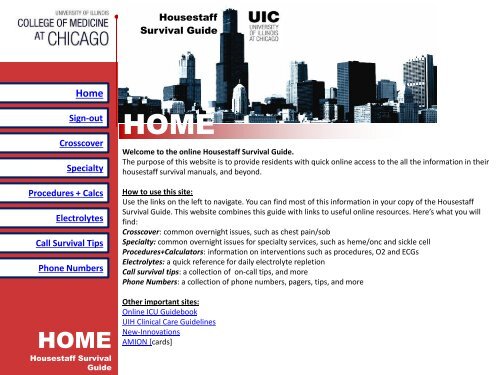
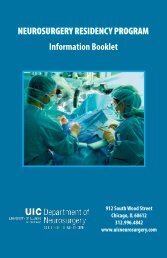
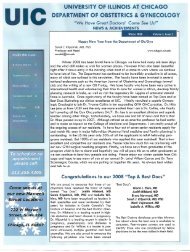
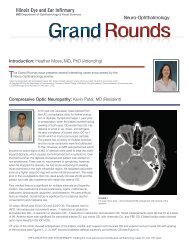
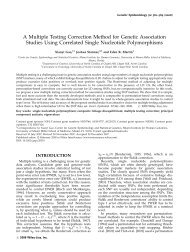
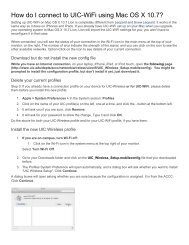
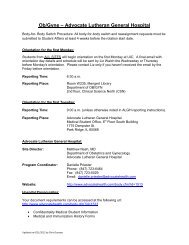

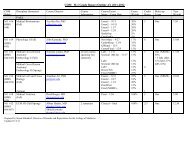

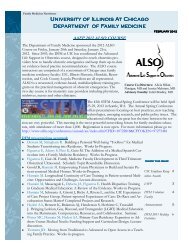
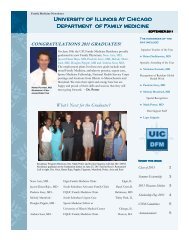
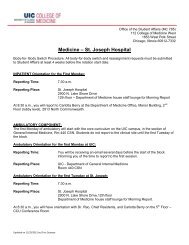
![CV Joan [W51] - University of Illinois College of Medicine at Chicago ...](https://img.yumpu.com/17336863/1/190x245/cv-joan-w51-university-of-illinois-college-of-medicine-at-chicago-.jpg?quality=85)
